
- MARKETPLACE
- DOWNLOAD BUSINESS KIT

How To Write a Catering Business Plan w/ Templates (PDF, Word Doc)
Whether you’re starting a catering business full-time or planning to operate out of your house initially , writing a business plan is essential to getting clear on the type of catering business you want to open. After all there’s some pretty important stuff covered inside of what can seem like a stuffy document.
For the purposes of starting a catering company, think about the business plan as the one place you put your operation details. Things like the cooking equipment you need to purchase and the total cost, tentative catering menu, food costs, and who your target customer is. These are all super important details you need to understand before opening! This document provides a place for you to organize everything.
By the end of this guide, you’ll be able to draft your plan and start on that first catering gig you’ve been planning to open. We also provide templates you can use in PDF and Word Doc you can download and edit. Let’s get started.
Page Contents
Executive Summary
Introduction, company description, mission statement, company concept, market analysis, target market, industry analysis, competitive analysis, management structure, product line and services, sales and marketing, financial plan, funding request, financial forecast, operational plan, download templates.

Catering spread for a Mexican food concept.
Start your business plan with an executive summary. This is a way to introduce your catering business so whoever is reading your business plan will know what to expect. This will include a brief introduction of your catering business, a description of your company, the services your catering business will be providing, and the customer focus.
A quick introduction helps the reader get a bird’s eye view of your catering business. Here you’ll be talking about what to expect and what you can offer as part of your catering service.
This section isn’t considered lengthy. This usually has two to three sentences. What you need to focus on when writing this down is by the end of it, your reader will more or less understand what your catering business is all about.
Here’s an example introduction you can use as a guide:
The Big Spoon is a small catering business headed by Lydia Smith. She specializes in Italian cuisine but can cater to American, Mexican, and Asian dishes as well. The Big Spoon can accommodate an intimate dinner for 2 up to a large party of 50 accompanied with table settings and chafing dishes to complete that delicious home-cooked meal experience.
Just by the introduction, the reader will know how big your catering business is, what cuisine they can expect to order, and how many people the business can cater for. It also gives them an introductory glance about your catering style wherein you already provide more than just food but also a table setting so they don’t have to look for a supplier for this separately.
Keep your introduction informative but also short enough. You will be able to add in more to the details later on.
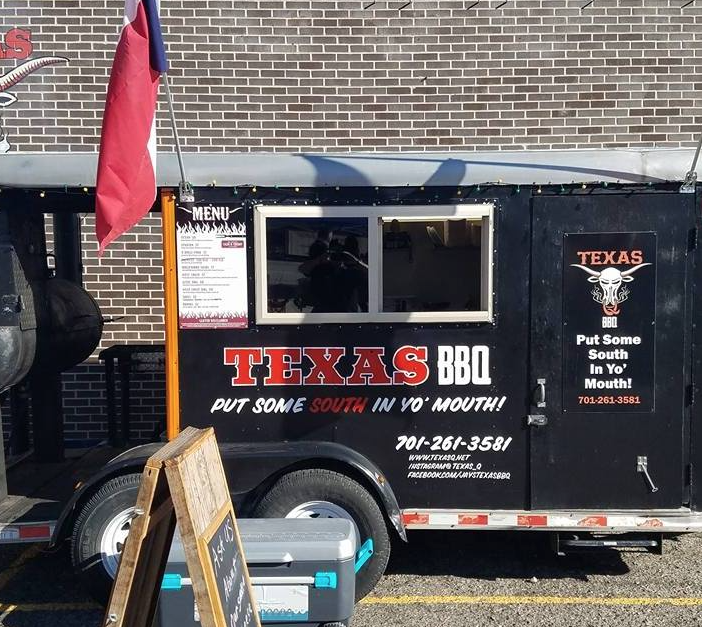
Some food trailers make more than 50% of their annual revenue from catering gigs.
A little background on your catering business is needed in the company description part of the business plan. Here, you can describe the meaning behind the name for your catering business, who the owners are, and what their roles are going to be. Who will be in charge of cooking? Who will be in charge of accounts and marketing?
This may just be brief but this is a way for you to introduce what’s going to happen behind the scenes of your catering business.
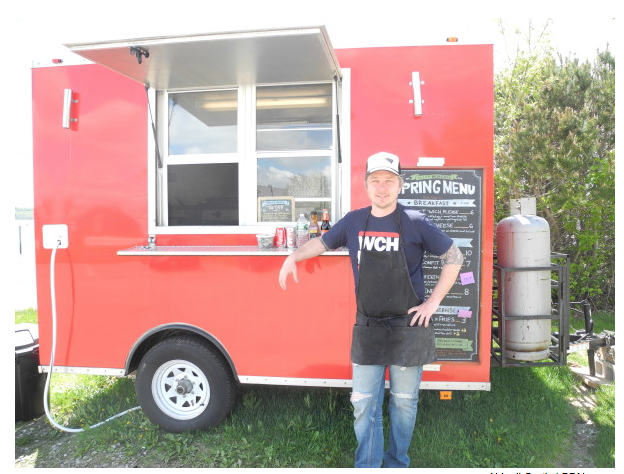
Catering works great for food trucks and restaurants.
Although your catering business may sound self-explanatory, it would still be of great help to you if you mentioned the services you’ll be offering.
For example, The Big Spoon already mentioned in their introduction that they’ll be catering food and offering table settings. They could also add that they will be offering an ice cream station and even a cocktail bar.
You will describe more of this in detail later on but you can summarize it and mention it here already.
Customer Focus
For a catering business to flourish, you must know your target market early on. And though a thorough explanation of that can be found in the Market Analysis section, you can briefly state them in this portion as well.
Also, remember that your customer focus would also have to coincide with your skills. You can’t be targeting customers who are vegans if your culinary skills and knowledge do not include cooking vegan food. This is why it’s important to write this early on so you can narrow down the customers you are planning to cater to.

What’s your mission statement?
Businesses with clear goals stated from the start lead to a successful operation. Why? Because every decision you make revolves around these goals which will lead you closer to success.
Here’s a sample mission statement to picture it out clearly:
The Big Spoon aims to cater delicious home-cooked meals to its customers. Every dish that is served will contain natural and fresh ingredients. We see to it that the service we provide is top-notch so that our customers will feel as if they are being served in a fine restaurant in the comforts of their own home or wherever they choose to have us cater them.
By writing this down in your business plan, you and your staff will have to stand by the standards you’ve set for yourselves. For instance, as stated in The Big Spoon’s mission statement, no fast food will be served and no artificial ingredients will be used so you and your staff will always remember this by heart.
By following this and revolving your decisions around your mission statement, you will be able to keep such standards which will lead to pleased and returning customers.

This is the section of the business plan where you can finally put in detail the concept you’ve been planning for your catering business. Remember the things you’ve been holding back in saying in the introduction? This is the time to write them all down now.
Related Reading: 7 Powerful Ways I Promote and Market My Catering Business
You can start by answering the following questions:
- What cuisine will you be offering?
- How many people can you cater to?
- Will you be offering healthy options such as vegan, keto, or paleo meals?
You may also add in other concept ideas that are not mentioned above. Just make sure to cover everything so you can have a basis for your product line and services to be tackled later on.
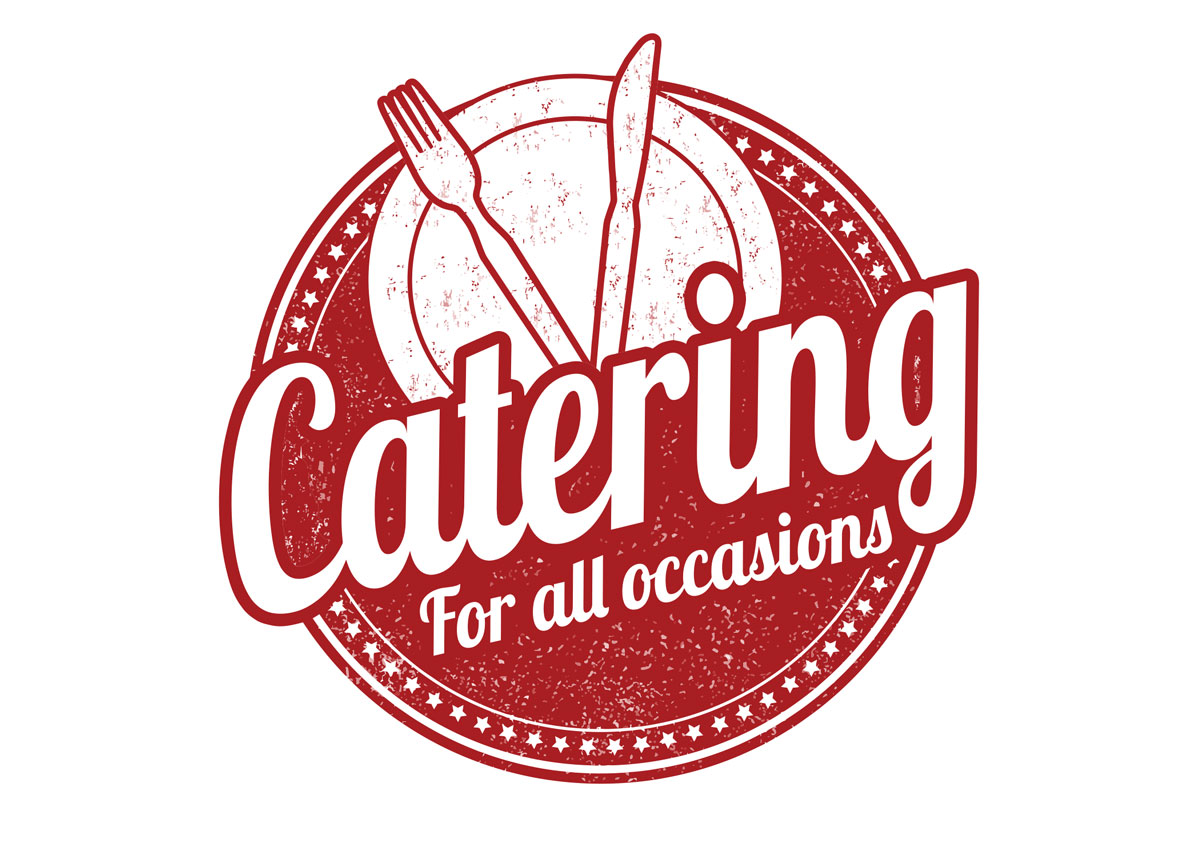
A compelling catering business logo.
Planning to put your business out there means you also have to know the industry you’ll be diving into. This is to help you analyze your potential customers, the growth of the catering business in your area, and the competition.
As mentioned above in the customer focus, your skills will have to match your target market. You’ve already written a brief introduction about it so in this section, all you have to do is to explain it in detail.

The catering business has been going on for a long while now so it’s important to gather in as much information as you can regarding this industry. This is to help you figure out if there is a potential market for your business and how to put your plans into action.
Another helpful guide is to look into the type of cuisine most people in your area look for. You can then incorporate it into your business and offer it as part of your menu.
The bottom line is that analyzing the industry around you helps you plan better for the future of your catering business.
You will not be the only catering business in your area. You’ll have to consider restaurants as your competition too. Check their prices and set menus. Do a competition check by tasting their food once in a while. Knowing who the players are in this competitive business game gives you the upper hand because you’ll be aware of their strengths and weaknesses and how to deal with them on the field.

Determine the key players in your business.
A catering service is run by a few people. In this section of the business plan, you’ll list down everyone who is working on this business alongside you as well as the roles they possess in your business. This includes:
- Business Partners
- Accountants
- Co-chefs (If you’re not the only one doing the cooking)
Why is this so important, you might ask? Stating clear business roles and laying out the management structure keeps everyone in check and helps avoid any misunderstandings. Most businesses that don’t define this early on end up having a messy workflow. So make sure to state each duty clearly for everyone to follow.

Burgers are a proven catering option.
This section of the business plan goes hand in hand with your company concept. Here you can present your different sample menus for all the cuisine you wish to cater to. Be sure to include the prices for the set menus per head.
You can also write down the services you plan to offer. Here are some you can consider for your catering business:
- Out of town catering
- Cocktail station
- Set up style (buffet or plated)
- Table setting (formal or casual, rustic or summer feel)
- Wait staff or food display only
Writing them all down in this section will keep your business more organized which is very important when you start on your catering business.
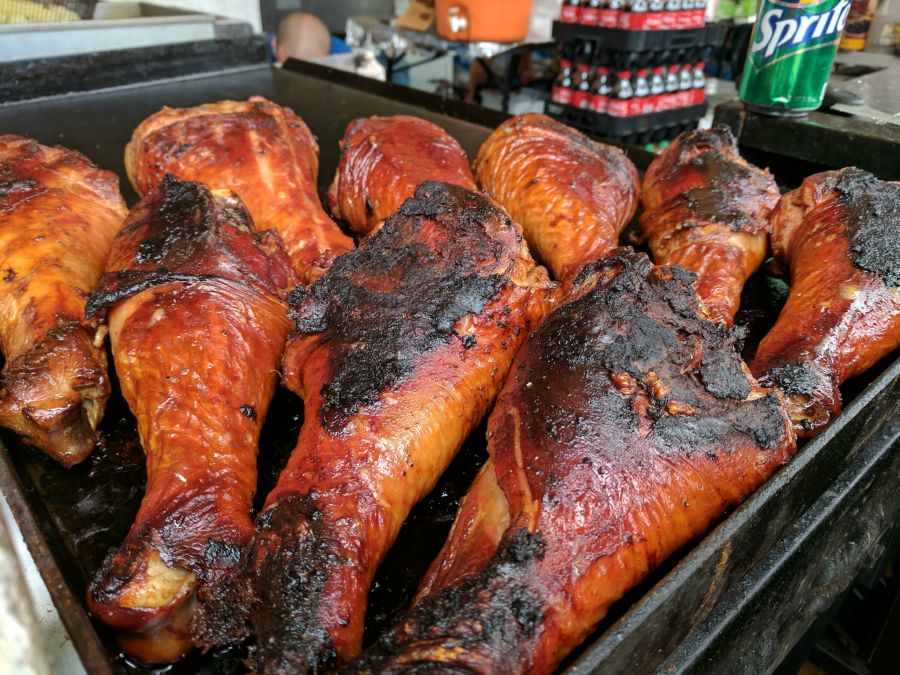
Grilled chicken is another popular option for caterers.
How are you going to market your catering business? Do you plan to have an ad out in your local newspaper and on social media? Both strategies are fine but you need to find more ways to get your catering business out there.
One way to market yourself is to partner up with rental spaces such as function halls that do not provide food. Give them a proposal that when there are inquiries regarding the rental of their halls, they would present your set menus to the guests as well so they don’t need to trouble over finding a caterer.
Related Reading: How I Started a Legit Catering Business Out of My House
Partnering with several event coordinators is also a way to get your business known. People these days hire event coordinators to do all the planning for them. They expect these coordinators to answer all their questions from food, music, and decorations. By partnering up with an event coordinator, they’ll be the ones to pitch in your catering business to their customers.
Remember to uphold your mission statement as well. By providing good food and high-class standards during your catering event, you’re already marketing your products and services to the number of people you’re catering to. So always make an exceptional first impression because that will stay with the guests long enough for them to remember hiring you on their next and succeeding events.

Plan your financial future.
Knowing where you’re going to get the funds to start your catering business is a must. This is how you’ll know if your plans are going to be achievable or not. Besides, having a solid financial plan will also allow you to go through with your ideas without any interruptions.
In this section, break down your financial plan into two categories which are your plans to request for funding and your financial forecast.
Some business owners are ready to put up their catering business due to having saved enough money through the years. But what if you lack the funds to do it? Don’t fret. You can still loan from the bank and invite investors.
Whatever your plan is that deals with requesting for funding, include it here so you can document it.
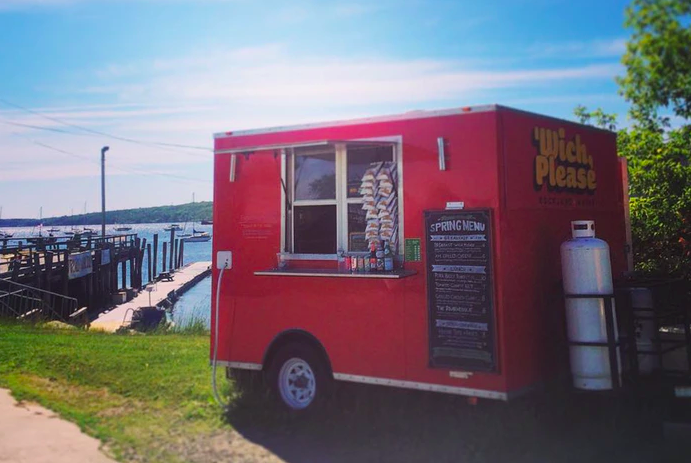
Make conservative and best case scenario financial forecasts.
Reaching break-even is the ultimate goal when you’re putting up a business. You can compute how long it will take you to reach it early on in the planning stage.
You can also list down all your proposed expenses here which include the following:
- Pots, pans, and other large kitchen appliances and tools for cooking
- Chafing dishes
- Dessert displays and trays
- Table cloths, plates, glasses, and utensils
- Uniforms for you and the staff
- Storage boxes and food warmers
You may also add in tables and chairs if you do not want to keep on renting these. But sometimes, the venue where you’ll be catering can provide these as well.
Download Now: Bakery Business Plan Templates for 2021
Be sure to include your staff’s payroll expenses. Since catering events are not done daily (unless you’ve already made a name for yourself and you’re booked every day), you can just have your wait staff be on call and pay them per catering event rather than a daily wage.
By computing these, you’ll know just how much you should allot for your startup capital and how much should your goals be to reach during every catering gig in order to profit off of it.

What’s your operation plan?
Put your plan into action by making a timeline of your operations. Here is an example:
Date Plan [Insert Date Here] – Finalize the business documents you need such as permits and registrations for your catering business.[Insert Date Here] – Start marketing your business on social media and the local news. Send out proposals for partnerships with event coordinators and function halls.[Insert Date Here] – Hire and train staff.[Insert Date Here] – Start catering when booked.[Insert Date Here] – Achieve goals and reach break-even.
The appendix section of the business plan is where you can put all your documentation. This includes photos of your food and table setting and your copies of the permits and registration for your catering business.
Here are the catering business plan samples in PowerPoint, Word Doc, Google Doc, and PDF. These are ideal for commercial or home-based catering businesses.
- Catering business plan template Google Doc
- PDF catering business plan sample
- Catering PowerPoint template
- Catering businesses are ideal because there is no space for you to rent which is considered one of the main expenses that can be quite heavy on the pockets. You will be cooking in the comfort of your own home. Just make sure your place can handle heavy cooking and there is enough space for you and your staff to move about.
- It would be nice to learn more about the different cuisines as you go along so you can cater to a wide variety of audiences.
- Include a checklist of all the equipment you need to operate at the start. These equipment requirements make up the bulk of your startup costs. You can download a checklist of frequently used catering equipment here .
Throughout this entire guide, we have been referring to your readers as one of the main reasons why you should make your catering business plan easy to understand. But in truth, making this business plan is for you as well. You will need this plan when you’re requesting for financial assistance in banks and this would also serve as your work guide. So remember to keep it detailed and easy to comprehend because you will be using this on the road to putting up your business.
While opening a catering business can be extraordinarily rewarding there are a few factors you should consider before deciding to push ahead. Creating a business plan lets you understand what the factors are, what’s going to make this business become a success, and how you can profit from the venture.
If you’re serious about starting a catering business, don’t forget to sign up for our Food Business Startup Kit . This free community will give you access to exclusive interviews with catering professionals you can use to help grow your own business.
Want to start your own food business?
Hey! 👋I’m Brett Lindenberg, the founder of Food Truck Empire.
We interview successful founders and share the stories behind their food trucks, restaurants, food and beverage brands. By sharing these stories, I want to help others get started.
If you liked this story, sign up for our newsletter that includes our food business startup kit and most popular interviews sent straight to your inbox.
Know someone interesting that should be interviewed on the website? Tell us about them here.
About the Author: Brett Lindenberg
Related Posts

175+ Brilliant Food Tasting Event Names For Your Consideration

(My Tips) 13 Smartest Ways to Save Money on Wedding Catering
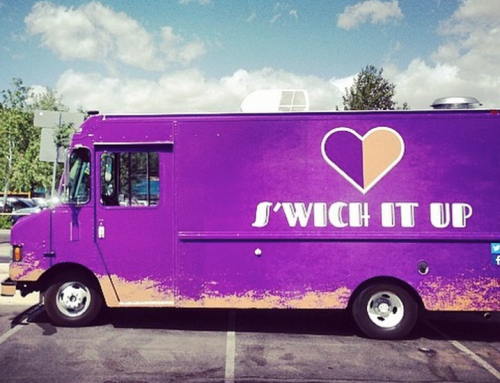
Corporate Catering Business: How to Find and Close More Leads
Wedding receptions: how to pull-off an unforgettable catering service guide.

Item added to your cart
Here is a free business plan sample for a catering company.

Have you been toying with the idea of launching a catering business but feel overwhelmed about where to start?
Look no further, as we're about to guide you through a comprehensive business plan tailored for the catering industry.
Creating a solid business plan is a crucial step for any aspiring entrepreneur. It serves as a roadmap, outlining your vision, objectives, and the strategies you'll employ to turn your catering dreams into a thriving reality.
To streamline your planning process and get you started on the right foot, feel free to utilize our catering business plan template. Our team of professionals is also on standby to provide a free review and fine-tuning of your plan.

How to draft a great business plan for your catering company?
A good business plan for a catering business must be tailored to the unique challenges and opportunities of the catering industry.
Initially, it's important to provide a comprehensive overview of the catering market. This should include current statistics and an analysis of emerging trends, similar to what we've outlined in our catering business plan template .
Your business plan should articulate your vision clearly, define your target market (such as weddings, corporate events, private parties), and establish your catering company's distinctive approach (gourmet, budget-friendly, ethnic cuisines, etc.).
Market analysis is a critical component. You'll need to thoroughly research local competitors, understand industry trends, and identify the preferences of potential clients.
For a catering business, it's imperative to detail your menu offerings. Describe your range of cuisines, menu flexibility for dietary restrictions, and how your selections cater to the tastes and needs of your intended clientele.
The operational plan is vital and should cover the logistics of your catering operations. This includes the location of your kitchen, the layout for food preparation and storage, supplier relationships for ingredients, and the logistics of transporting food to event venues.
Quality control is paramount in catering. Your plan should highlight your commitment to food quality, preparation standards, and adherence to health and safety regulations.
Marketing and sales strategies must be addressed. How will you build a client base and foster repeat business? Discuss promotional tactics, networking strategies, and customer service excellence.
Incorporating digital marketing efforts, such as a professional website and active social media engagement, is crucial for modern businesses.
The financial section is a cornerstone of your business plan. It should outline your startup costs, projected revenue, operating expenses, and the point at which you expect to turn a profit.
Catering businesses often deal with fluctuating costs and varying client demands, making financial planning especially important. To assist with this, consider using our financial forecast for a catering business .
Compared to other business plans, a catering business plan must address specific factors such as menu diversity, event-specific logistics, staffing for different types of events, and the scalability of services.
A comprehensive business plan is a tool for clarifying your strategy and attracting investment or loans.
Investors and lenders will look for a thorough market analysis, sound financial projections, and a clear plan for managing the complexities of catering operations.
By presenting a detailed and substantiated business plan, you showcase your professionalism and dedication to the success of your catering enterprise.
To streamline the planning process and ensure you cover all necessary elements, you can start with our catering business plan template .
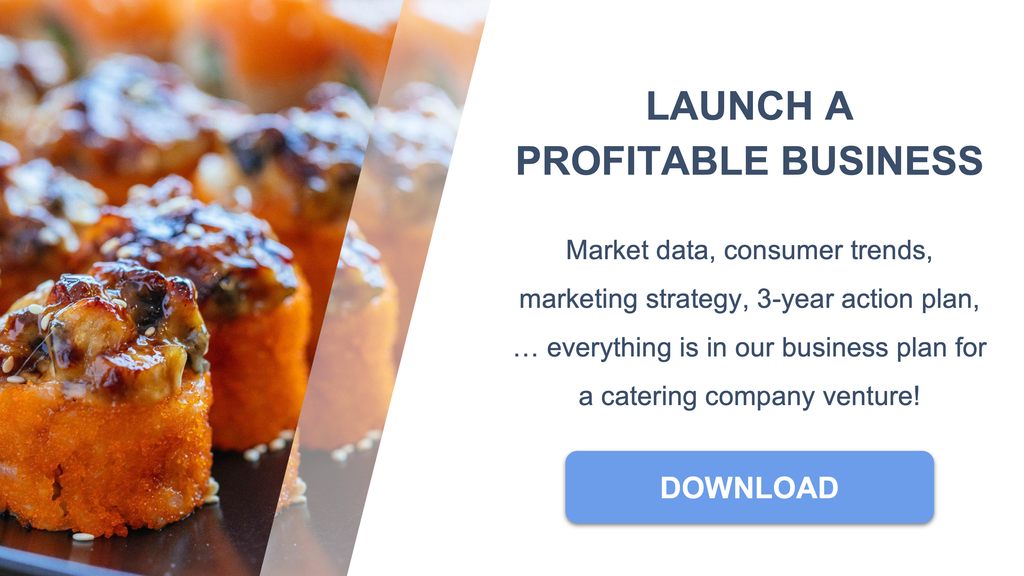
A free example of business plan for a catering company
Here, we will provide a concise and illustrative example of a business plan for a specific project.
This example aims to provide an overview of the essential components of a business plan. It is important to note that this version is only a summary. As it stands, this business plan is not sufficiently developed to support a profitability strategy or convince a bank to provide financing.
To be effective, the business plan should be significantly more detailed, including up-to-date market data, more persuasive arguments, a thorough market study, a three-year action plan, as well as detailed financial tables such as a projected income statement, projected balance sheet, cash flow budget, and break-even analysis.
All these elements have been thoroughly included by our experts in the business plan template they have designed for a catering .
Here, we will follow the same structure as in our business plan template.

Market Opportunity
Market overview and potential.
The catering industry is an essential segment of the food services market, offering vast opportunities for growth and innovation.
As of recent estimates, the global catering market size is valued at several billion dollars, with expectations for continued expansion. This growth is driven by an increase in corporate events, social gatherings, and a general preference for professionally prepared meals for various occasions.
In the United States, the catering industry contributes significantly to the economy, with thousands of catering companies operating across the country, generating substantial revenue annually.
This data underscores the pivotal role that catering services play in the food industry and highlights the potential for new entrants to make their mark.
Industry Trends
The catering industry is experiencing a shift towards more personalized and health-conscious dining experiences.
There is a rising demand for organic, non-GMO, and locally sourced ingredients, as clients are more aware of the health and environmental impacts of their food choices.
Customization is becoming increasingly important, with clients seeking unique and tailored menus to suit dietary restrictions and personal preferences, such as gluten-free, keto, or vegan diets.
Technology is also playing a role in transforming the catering business, with online ordering systems and event management software streamlining operations and enhancing customer engagement.
Sustainability practices are being integrated into catering operations, from reducing food waste to using eco-friendly packaging and utensils.
These trends are shaping the future of catering, as providers adapt to the evolving demands of modern consumers and event planners.
Key Success Factors
Several factors contribute to the success of a catering business.
High-quality food that is both delicious and presented elegantly is fundamental to a caterer's reputation and client satisfaction.
Versatility in menu offerings allows a catering service to accommodate a wide range of events and dietary needs, enhancing its marketability.
Strategic partnerships with event planners, venues, and suppliers can lead to a steady stream of business and opportunities for growth.
Exceptional customer service, including clear communication and the ability to execute events flawlessly, is critical for building trust and repeat business.
Efficient operations, including cost control, inventory management, and staff training, ensure that the business runs smoothly and profitably.
Adapting to industry trends, such as incorporating sustainable practices and leveraging technology, will position a catering company as a forward-thinking and competitive player in the market.
The Project
Project presentation.
Our gluten-free catering service is designed to cater to the increasing number of individuals with gluten sensitivities, celiac disease, or those who prefer a gluten-free lifestyle. Strategically positioned to serve both private events and corporate functions, our catering service will provide a diverse menu of gluten-free options, including appetizers, main courses, sides, and desserts, all crafted with premium, certified gluten-free ingredients.
We emphasize the flavor, presentation, and nutritional value of our dishes to ensure a delightful and satisfying dining experience for all our clients.
Our catering business is poised to set the standard for gluten-free dining experiences, enhancing the lives of our clients by accommodating their dietary needs without compromising on taste or quality.
Value Proposition
The value proposition of our gluten-free catering service lies in our dedication to delivering a gourmet dining experience tailored to the gluten-free community. We understand the challenges faced by those with dietary restrictions and are committed to providing a diverse menu that is both safe and delectable.
Our pledge to culinary excellence and dietary safety offers peace of mind and enjoyment to our clients, contributing to their health and satisfaction.
We strive to create a welcoming atmosphere for all guests, regardless of their dietary preferences, and are dedicated to educating our clientele about the advantages of gluten-free dining.
As a leader in gluten-free catering, we aim to be a cornerstone in the community, presenting a viable and appetizing alternative to traditional catering options and enhancing the well-being of our clients.
Project Owner
The project owner is a seasoned professional with a passion for catering and a comprehensive understanding of gluten-free dietary requirements.
Armed with experience in event planning and a background in nutrition, the owner is driven to establish a gluten-free catering service that excels in quality, creativity, and customer service.
With a commitment to education and dietary awareness, the owner is dedicated to offering exquisite gluten-free meals that contribute to the health of clients and the success of their events.
Their dedication to culinary artistry and their zeal for exceptional service are the cornerstones of this venture, aiming to enrich the dining experiences of those in need of reliable and delicious gluten-free options.
The Market Study
Market segments.
The market segments for this gluten-free catering service are diverse and multifaceted.
Primary clients include individuals with gluten intolerance or celiac disease who require strict gluten-free diets for their health and well-being.
Additionally, there is a growing demographic of health-conscious individuals who opt for gluten-free meals as part of a lifestyle choice or dietary preference.
Corporate clients seeking to accommodate the dietary needs of their employees or guests during events also represent a significant market segment.
Lastly, event planners and hosts who aim to provide inclusive menu options for weddings, parties, and other social gatherings are potential customers for our services.
SWOT Analysis
Conducting a SWOT analysis for the gluten-free catering business highlights several factors.
Strengths include specialized knowledge in gluten-free meal preparation, a commitment to high-quality ingredients, and the ability to offer a diverse menu catering to various dietary needs.
Weaknesses may involve the higher costs associated with sourcing premium gluten-free ingredients and the complexity of ensuring cross-contamination is avoided.
Opportunities can be found in the increasing awareness and demand for gluten-free options, as well as the potential to partner with health professionals who can refer clients with dietary restrictions.
Threats include the growing number of competitors in the gluten-free catering space and the volatility of prices for gluten-free ingredients.
Competitor Analysis
An analysis of competitors within the gluten-free catering industry shows a competitive landscape.
Direct competitors include other catering services that offer gluten-free menus and restaurants with gluten-free takeout options.
These businesses compete on the basis of menu diversity, ingredient quality, price points, and service excellence.
Identifying competitive advantages such as unique menu offerings, exceptional customer service, and strong partnerships with suppliers can help in carving out a niche in the market.
Understanding the strengths and weaknesses of these competitors is crucial for developing strategies to differentiate and build customer loyalty.
Competitive Advantages
Our gluten-free catering service's competitive advantages lie in our unwavering dedication to quality and customer satisfaction.
We offer a wide array of appetizing and nutritious gluten-free dishes, crafted to meet the needs of our diverse clientele without compromising on flavor or presentation.
Our commitment to educating our clients and their guests about the benefits of gluten-free dining, along with our transparent ingredient sourcing, helps to establish trust and loyalty within our customer base.
Moreover, our adaptability to cater to various event sizes and settings gives us the flexibility to provide personalized and memorable experiences for every occasion.
You can also read our articles about: - how to start a catering company: a complete guide - the customer segments of a catering company - the competition study for a catering company
The Strategy
Development plan.
Our three-year development plan for the gluten-free catering service is designed to establish us as a leader in the industry.
In the first year, we aim to build a strong reputation for our unique gluten-free menus and exceptional service, focusing on corporate events, weddings, and private parties.
The second year will be about expanding our reach by partnering with event planners and venues, and offering our services to a wider array of events and clients.
In the third year, we plan to diversify our offerings with seasonal and culturally diverse gluten-free menus, and to start offering cooking classes and workshops to engage with our community.
We will consistently prioritize the quality of our ingredients, customer service excellence, and innovative menu design to cater to the evolving tastes and dietary needs of our clients.
Business Model Canvas
The Business Model Canvas for our gluten-free catering service targets individuals and organizations looking for high-quality, gluten-free food options for their events.
Our value proposition is delivering a memorable dining experience with a diverse range of gluten-free dishes that do not compromise on taste or presentation.
We offer our catering services through direct engagement with clients, as well as through our website and social media platforms, utilizing our skilled chefs and event coordinators as key resources.
Key activities include menu development, event planning, and client consultations.
Our revenue streams are generated from catering events, while our costs are associated with high-quality ingredient procurement, labor, and marketing efforts.
Access a detailed and customizable Business Model Canvas in our business plan template .
Marketing Strategy
Our marketing strategy is centered on showcasing the quality and creativity of our gluten-free catering menus.
We plan to engage with our target market through food tasting events, partnerships with gluten-free influencers, and by providing educational content on the benefits of gluten-free diets.
Collaborations with nutritionists and dietitians will help validate our offerings and build trust with potential clients.
We will leverage social media platforms and targeted advertising to increase visibility and attract a diverse clientele interested in healthy, gluten-free options for their events.
Risk Policy
Our risk policy for the gluten-free catering service focuses on mitigating risks associated with food preparation, ingredient sourcing, and event execution.
We will adhere to strict gluten-free protocols and cross-contamination prevention measures to ensure the safety of our clients with gluten sensitivities.
Regular staff training and quality control checks will be implemented to maintain high standards. We will also manage costs effectively to ensure financial stability.
Comprehensive liability insurance will be in place to protect against any unforeseen incidents related to our catering services.
Why Our Project is Viable
We are committed to filling a gap in the market with our gluten-free catering service, addressing the needs of a growing demographic that values health and dietary inclusivity.
With our dedication to culinary excellence and customer satisfaction, we believe our business is well-positioned for success in the competitive catering landscape.
We are enthusiastic about the positive impact our service can have on the well-being of our clients and are ready to adapt to the industry's demands to achieve our vision.
We look forward to the exciting opportunities ahead and the chance to become a trusted name in gluten-free catering.
You can also read our articles about: - the Business Model Canvas of a catering company - the marketing strategy for a catering company
The Financial Plan
Of course, the text presented below is far from sufficient to serve as a solid and credible financial analysis for a bank or potential investor. They expect specific numbers, financial statements, and charts demonstrating the profitability of your project.
All these elements are available in our business plan template for a catering and our financial plan for a catering .
Initial expenses for our gluten-free catering business include acquiring commercial kitchen equipment designed for gluten-free meal preparation, adapting the kitchen space to comply with food safety regulations, sourcing certified gluten-free ingredients, specialized staff training for proper handling of gluten-free products, as well as costs associated with branding and initiating targeted marketing campaigns to reach our niche market.
Our revenue projections are based on a thorough market analysis of the demand for gluten-free catering services, taking into account the increasing awareness of dietary restrictions and the preference for high-quality, specialized catering options.
We expect a gradual increase in sales, beginning with conservative estimates and expanding as recognition of our gluten-free catering services grows within the community and beyond.
The projected income statement outlines anticipated revenues from our gluten-free catering events, production costs (ingredients, labor, utilities), and operating expenses (facility lease, marketing, staff wages, etc.).
This leads to a forecasted net profit that is essential for assessing the long-term viability of our catering venture.
The projected balance sheet presents assets unique to our business, such as kitchen equipment, ingredient inventories, and liabilities including loans and projected operational costs.
It provides a snapshot of the financial standing of our gluten-free catering service at the conclusion of each fiscal period.
Our projected cash flow statement details the inflows and outflows of cash, enabling us to predict our financial requirements at any point in time. This will be crucial for maintaining financial stability and preventing cash flow issues.
The projected financing strategy identifies the specific sources of funding we intend to utilize to cover our initial costs.
The working capital requirement for our gluten-free catering business will be diligently tracked to ensure we have sufficient liquidity to support our day-to-day operations, which includes ingredient purchases, inventory control, and payroll.
The break-even analysis for our venture will determine the volume of catering events needed to offset all our costs, including the initial investments, and to begin generating profits.
It will signal the point at which our business becomes financially sustainable.
Key performance indicators we will monitor include the profit margin on our gluten-free catering services, the current ratio to evaluate our ability to meet short-term liabilities, and the return on investment to gauge the efficiency of the capital we have deployed into the business.
These metrics will assist us in assessing the financial health and overall success of our gluten-free catering enterprise.
If you want to know more about the financial analysis of this type of activity, please read our article about the financial plan for a catering company .
- Choosing a selection results in a full page refresh.
- Opens in a new window.
Upmetrics AI Assistant: Simplifying Business Planning through AI-Powered Insights. Learn How
Business Planning
- Financial Forecasting
AI Assistance
See How Upmetrics Works →
Strategic Planning
Entrepreneurs & Small Business
Accelerators & Incubators
Business Consultants & Advisors
Educators & Business Schools
Students & Scholars
- Sample Plans
Business Plan Course
Small Business Tools
- Strategic Canvas Templates
E-books, Guides & More
- WHY UPMETRICS?
Customers Success Stories
- Business Plan Builder
- Canvas Modeling
- Product Tour
- Business Consultants and Advisors
- Entrepreneurs And Small Businesses
- Accelerators & Incubators
- Educators & Business Schools
- Students & Scholars
- Sample Business Plans
- business plan course
- E-Books, Guides & More
- Success Stories
- Food, Beverage & Restaurant
Catering Business Plan

How Can a Catering Business Plan Help You?
The catering business is one of the most rewarding careers as it not only lets you pursue your passion, it has the potential to grow into a huge business by size and volume if planned properly.
A business plan is helpful for a catering business because along with great cooking skills, great management skills are an integral part of a successful catering business.
A business plan can help you conduct your daily business activities without chaos, have good finances, help you find your desired customers, and make your unique business idea a marketable one.
Things to Consider Before Writing Your Catering Business Plan
Make a list of items you can serve.
Having a list of items you will serve, helps you organize your services better. It also helps your customers understand what you can offer and decide if your service is the right one for them or not.
It also becomes important that you design your menu as per your target audience’s tastes and preferences.
Figure out your location and staffing coasts
Figure out from where you’ll provide services, what would be the amount of rent you’ll have to pay, which location would be good for your business , etc.
Apart from that, you also need to figure out staffing costs, the size of your team, the skills required, and so on.
Figure out where you’ll get your supplies from
Getting good supplies is essential for a catering business. Because you need to pay attention to quality as well as the taste of the food you’ll offer. Having a fixed supplier helps you maintain consistency in the quality of your food.
Make a list of important equipment
Although many catering services work on the go and prefer to rent equipment, it is a good practice to have the basic equipment in case of contingency. It would also decrease your reliance on other people, and pose fewer challenges while gathering supplies for new orders.
Having your equipment also makes it easier for you and your team to prepare orders as you get familiar with how to use those tools.
Now that you have done the research, let’s learn how you can write a business plan for yourself.
How to Write a Catering Business Plan?
A good catering business plan consists of a clear description of your business’s functioning, your target market, the services you offer, the size of your company, a pricing strategy, and a well-designed employee management system.
Now you might wonder, where to start from, how to go about writing a plan from scratch, and most importantly how to know if you have written a good one.
Well, you need not worry.
You can easily write a well-rounded business plan either through a pre-designed template or through online business plan software.
Moreover, online business plan software can help you write a flexible business plan that grows alongside your business.
Catering Business Plan Outline
This is the standard catering business plan outline which will cover all important sections that you should include in your business plan.
- Keys to Success
- Financial Summary
- Legal Entity
- Locations and Facilities
- Facility Design
- Boxed lunches
- Buffet style lunches
- Alternative Providers
- Future Products
- Internal Bright Future Customers
- Nonprofit External Customers
- For-profit External Customers
- Market Analysis
- Market Trends
- Market Growth
- Value Proposition
- Competitive Edge
- Distribution Strategy
- Marketing Programs
- Pricing Strategy
- Promotion Strategy
- Of Grape & Grain
- Cravings Fine Foods
- Ariana’s Deli
- Fettuccini and Co
- Napoli Restaurant
- Brindiamo Catering
- Wild Duck Brewery
- Oregon Electric Station
- Local and national grocery stores chains
- Local and national sandwich fast-food chains
- Strategic Alliances
- Organizational Structure
- Management Team Gaps
- Personnel Plan
- Other General Assumptions
- Fundraising Strategy
- Fundraising Programs
- Funding Forecast
- Start-up Summary
- Income Statement (5-Year Projections)
- Balance Sheet (5-Year Projections)
- Cash Flow (5-Year Projections)
Although your plan will keep changing as your business grows, here are a few key sections that would form the foundation of your business plan:
1. Executive summary
This executive summary section would be the first one on your plan. It provides a summary of all that your business stands for. It can be divided into the following subsections:
- Objectives : This segment would consist of the chief objectives of your company. What it aims to achieve, who it wants to serve, and where it wants to reach.
- Mission : This segment includes the mission statement of your business, it consists of what market gap you plan on filling with your business.
- Financial Summary : This segment will give a summary of the past and present condition of your finances as well as projected gains of your business.
A clear executive summary can come in handy if you need funding.
2. Operational Strategy
The operational strategy section helps you plan how to work toward achieving your business goals. It can be divided into the following subsections:
- Day-to-day activities : In this segment, you’ll write an overview of the best way of carrying out your business from onboarding clients to fulfilling the services.
- Long-term goals : This section would consist of long-term goals like serving a certain number of clients, growing your business to a certain size, and expanding to a certain number of branches, etc.
A good operational strategy would make your business activities less chaotic and prevent them from being all over the place.
3. Market Analysis
In this segment, you’ll write down every single detail you can find out about the market. It would include the following segments:
- Market trends : Knowing about all the prevailing market trends can help you design a plan that would change as per the evolving market, and also help you maintain the foundation your company stands on. It would also give you an overview of what your competitors are doing.
- Target Market : This segment would describe everything about your target market. The locations they prefer, the kind of cuisines they are into, how and when they procure catering services, etc.
This segment helps you understand what you are getting yourself into.
4. Services
This section consists of a detailed description of the services you offer. For example, the events you cater to, the volume of people you can serve, the food options your services have, what additional services you offer, etc.
This segment helps your target audience understand your services better, it helps them in deciding whether you are the right fit for them or not. So, make sure you describe your services in a clear and precise manner.
5. Financial Plan
The financial plan segment includes everything starting from the funds you need to start your business, the funds you need for procuring supplies and employing people, the projected cash flow of your business, expected profit, and loss of your business, pricing strategy, etc.
Download a sample catering business plan
Need help writing your business plan from scratch? Here you go; download our free catering business plan pdf to start.
It’s a modern business plan template specifically designed for your catering business. Use the example business plan as a guide for writing your own.
The Quickest Way to turn a Business Idea into a Business Plan
Fill-in-the-blanks and automatic financials make it easy.

Write your business plan with Upmetrics
A business plan software like Upmetrics is the best way to draft your business plan. This incredible tool comes with step-by-step instructions, customizable templates, and 400+ sample business plans to help you get started.
So, whether starting a catering business or planning to grow an existing one, Upmetrics is the tool you need to create a business plan.
So what are you waiting for? Start planning today!
Related Posts
Restaurant Business Plan
Cloud Kitchen Business Plan
10 Important Business Plan Components
400+ Sample Business Plan Examples
Hire a Business Plan Writer
Business Plan Cover Page Design Process
Frequently asked questions, how do i write a business plan for catering.
Writing a catering business plan from scratch requires a lot of research, but you can report it most effectively with the help of a catering business plan example. Using our business plan software, you can also quickly finish your plan in just a few hours or less.
What should be included in a catering business plan?
These are the key components of a business plan your catering plan must include to stand out to investors:
- Executive summary
- Business Overview
- Products and services
- Sales and marketing strategies
- Operations plan
- Management team
- Financial plan
Where to find business plan writers for your catering business?
While many business plan writers are available to help you, believe it or not, no one knows your business better than you. So we recommend you write your catering business plan and outline your vision as you have in your mind. You can use AI business plan generators like Upmetrics to speed up the writing process.
What are some common mistakes to avoid when writing a catering business plan?
Following are some of the common mistakes to avoid when writing a catering business plan:
- Poor market research and ignoring industry trends.
- Inadequate and inaccurate financial projections.
- Undefined goals and lack of details.
- Including outdated and irrelevant information.
- Not proofreading the document for typos and grammatical errors.
- Not regularly updating your business plan.
About the Author
Upmetrics Team
Upmetrics is the #1 business planning software that helps entrepreneurs and business owners create investment-ready business plans using AI. We regularly share business planning insights on our blog. Check out the Upmetrics blog for such interesting reads. Read more

Plan your business in the shortest time possible
No Risk – Cancel at Any Time – 15 Day Money Back Guarantee
Popular Templates

Create a great Business Plan with great price.
- 400+ Business plan templates & examples
- AI Assistance & step by step guidance
- 4.8 Star rating on Trustpilot
Streamline your business planning process with Upmetrics .

How to Create a Catering Business Plan (Plus Free Template)

Elizabeth started her career at a small local restaurant close to her home. She had big dreams of owning a large catering business.
Three years later, she learned the ropes, worked hard enough to save money and was ready to launch Chefdini Catering.
Hers is a tale of overcoming all odds.
Within five years, Elizabeth expanded her operations. She employed some staff and was raking in around $5 million in revenue annually.
In an era where 20% of new businesses fail within the first two years, according to the US Bureau of Labor Statistics, how did Elizabeth pull this off?

Well, it may have taken five years, but one thing that helped her navigate her journey smoothly was:
…a Catering Business Plan.
And she’s not alone. About 70% of new businesses that manage to survive for five years follow a strategic business plan in the US.
So while several factors contribute to businesses failing within the first couple of years, there’s no doubt lack of a business plan is a major reason.
And this isn’t far-fetched.
Imagine building a house without floor plans. How long do you think it’s going to stand? Not long enough.
That’s precisely what happens when you operate your drop-off catering business without a solid plan. And this has nothing to do with how passionate you are.
Think of a business plan as a roadmap or a guide that outlines your goals and details how you intend to achieve them. It’s central to how you start and grow your business. Also, it turns your visions into a concrete action plan for success.
Having a plan is essential for drop-off caterers hoping to thrive in the current, highly competitive catering industry.
As you read this, over 12,000 establishments are vying for the same customer as you. So running a catering business without a solid plan will only give an opening for your competitors to be many steps ahead of you.
Take Abbey Duke, CEO of SugarSnap Catering, for instance.
From the get-go, part of her strategy was to always stay competitive by serving her customers how they prefer.
So when the pandemic hit and online ordering became the norm, she quickly leaned on HoneyCart’s order automation software to give customers the convenience they desired. And at the same time, to ensure she wasn’t losing sales to her competitors.
In her words:
“But I knew if we didn’t offer online ordering, we’d be losing sales to companies like Panera that make it easy to order. Busy customers expect convenience and will often choose it over quality.”
Making this kind of game-changing decision at a moment’s notice is one of the perks of having a solid business plan.
Now, you may be wondering:
“How do I create an effective catering business plan?” One that gives you an edge over your competitors and sets you on the path to success like Elizabeth.
Well, I got you covered.
We’ve developed a free catering business plan template you can customize to your specific needs. I know, creating a business plan, even with a free template, is still a daunting task for drop-off caterers.
Don’t worry.
As we progress through this article, I’ll guide you on how to create one step-by-step.
Download the free template to follow along with me:

Before we dive in, let’s take a look at some reasons why you must have a catering business plan.
Five Reasons Why You Need a Catering Business Plan
1. it shows you mean business.
Today, technology has made it easy for anyone to start a catering business. Even amateurs can create an Instagram account, post some mouthwatering dishes and wait for orders to flood in.
But is this strategy going to cut it in the long run?
Absolutely not!
If you intend to scale your business, then it starts with a foolproof business plan. One that gives you insight into where your business is headed in the next five to ten years.
Having a business plan also emphasizes the commitment of you and everyone involved. It guides you in making smart decisions that will help scale your operations.
However, a catering business plan isn’t set in stone. This means you can change the plan as you progress. But the overall goals remain the same.
2. It Increases Your Chances of Securing Investments
Take Elizabeth, the fictional character I used at the start of this article.
One reason she could expand her business within five years is that she secured investment and raised funds.
And what’s one crucial thing potential investors will ask before giving you funds?
Yep, that’s right – a well-detailed business plan.
Imagine she didn’t have one. She wouldn’t have been able to raise the funds needed to expand her operations.
Here’s why:
Investors like to see your plans for scaling the business, its financial projections, industry analysis, level of risk involved, and so on.
Not having a business plan shows you are not intentional about scaling. And this significantly reduces the chances of securing funds needed to expand.
To drive home my point, Tim Berry, founder of Palo Alto Software , did a survey asking his customers questions about their businesses, goals, and business planning.
The result?

From the above report, you’ll see that those who had business plans were almost twice more likely to grow their businesses by securing capital than those who didn’t write a plan.
This emphasizes the importance of having a business plan.
3. It Helps You Understand Your Competitors
A business plan isn’t complete without researching and analyzing your competitors.
Because it helps you understand what they are doing, their offerings, pricing, and how you can improve on them.
Michele Levy , an independent brand strategy consultant agrees:
“Keeping track of who your competitors are, what people are saying about them, and what they are saying themselves can help you differentiate your business and stay ahead of trends that could impact your business.”
Furthermore, it’s a way to:
- Learn more about the latest market trends
- Recognize opportunities your competitors don’t offer
- Get an idea of your ideal customer persona
- Threats to your business
- Understand the catering industry better.
As a result, you can create a strategic plan that will improve your business.
4. Discover New Opportunities
Another benefit of creating a catering business plan is discovering new opportunities to boost your business in ways you never imagined.
Through research and competitive analysis, you may realize there are one or more niches that are underserved in your area.
So, instead of doing what every other drop-off caterer does, you can carve out a niche for yourself by doing something different.
For example, during the global pandemic that crippled catering activities, Chef Jolie of Low Country Quisine needed another source of revenue.
So she went back to the drawing board.
The result? She launched a Gourmet Takeaway Service.
By making it a habit to spot opportunities in market trends, she realized the need for an online ordering platform.
According to her:
“We needed to find new ways to generate revenue during the pandemic. We launched our Gourmet Takeaway Service and needed an online platform for customers to order.”
And if she didn’t do this, here’s what would have happened:
“We would not have been able to reach as many customers without the ability to accept orders and payments online.”
5. Measure the Success of Your Business
One of the goals of running a business is to hit milestones and achieve major goals.
And the only way to measure your success is to compare results with the actual plan. This way, you can see whether you’ve achieved your operational and financial goals within a specific timeframe.
For example, you set a goal of getting at least 150 customers within six months, expanding to at least four locations within 12 months, or like Elizabeth, hit $5 million annually.
By documenting these goals, not only does it make you committed to achieving them, but it also ensures you have something to measure your success against.
And it will give you a sense of fulfillment when you finally accomplish your goals. Without a doubt, a well-documented business plan fast-tracks achieving your goals.
Now that you know the importance of a catering business plan, let’s look at the essential elements of an ideal business plan.
Essential Elements of a Catering Business Plan
Creating a catering business plan may sound like a daunting task. But in reality, it isn’t. It’s not much different from the usual business plan.
However, it focuses on elements specific to the food and catering industry.
So what are these elements?
- Confidentiality Agreement
- Executive Summary
- Business Focus
- Market Research
- Marketing Plan
- Financial Plan
Let’s take a brief look at what each of these elements should contain.
Want to create yours as you go through this guide?
Don’t forget to download (and make a copy) of the template here .
1. Confidentiality Agreement
How do you ensure anyone reading your business plan doesn’t disclose the content to other people?
That’s where a confidentiality agreement comes in.
It’s an agreement between you and anyone reading your business plan not to reveal the content to any other person without your permission.
And to be on the safe side, you should have a proper legal counsel review any agreement you use in your business.
So if they do reveal the content, you will have the right protections in place.
Here’s an example of a confidentiality agreement:
The undersigned reader of [Company’s Name] Business Plan acknowledges that the information provided is completely confidential. Therefore, the reader agrees not to disclose anything found in the business plan without the express written consent of [Business Owner’s Name].
It is also acknowledged by the reader that the information to be furnished in this business plan is in all aspects confidential in nature, other than information that is in the public domain through other means, and that any disclosure or use of the same by the reader may cause serious harm and or damage to [Company Name].
Upon request, this business plan document will be immediately returned to [Business Owner’s Name].
This is a business plan. It does not imply an offer of any securities.
Applicable Law
This contract shall be governed by the laws of the County of ________ in the State of _______ and any applicable Federal law.
________________________________
Printed Name
2. Executive Summary
They say you only get one chance at a first impression. An executive summary is an opportunity to show anyone reading it what your catering business is about.
Chances are, if it lacks specific information or doesn’t capture the reader’s attention, they may not read further.
The executive summary should include a brief introduction to your catering business, your services, and who you cater to.
Here’s an example of an executive summary of Elizabeth’s fictional catering business.
Chefdini is a small catering business located in Georgia. It was founded by Elizabeth White six years ago. We specialize in Asian cuisine but also cater to Mexican and Italian dishes. Chefdini operates off-premise and on-premise catering with a focus on events, retreats, and social gatherings.
At a glance, this brief introduction shows what Chefdini is about, the kind of cuisines they specialize in, and who their audience is. Anyone who reads it can immediately get an idea of what to expect.
3. Business Focus
The business focus details how you’ll run your business, so anyone reading it will have a clear understanding of plans, goals, and priorities.
Information to include in your business focus are:
- Mission statement: an action-based statement that declares the purpose of your business, what you want to achieve, and how you intend to do it.
- Business details: a summary of your business, the founders, business location, services, and ethos.
- Professional support: details of any professional help you have received from an individual, an organization, or the government.
- Founders: history and background of anyone involved in starting the business
- Team members: details of those involved in the operations of the business and their roles.
- Aims & Objectives: as the name implies, here you include the details of what you hope to achieve with your business and the steps you’ll take to achieve it. Your aims and objectives can be short, medium, or long-term.
4. Market Research
Dan Zarrella , an analytical marketing leader and author of four books on marketing once said:
“Marketing without data is like driving with your eyes closed.”
And how do you get this data? Through Market Research.
Market research is the process of gathering information to understand your target market better. As such, it’s a fundamental part of a business plan.
Under market research, you’ll find:
Client Research
Your clients are the set of people who need your catering services and are most likely to pay for them.
To have any chance of making sales, you need to understand your ideal customers, their pain points, challenges, and how you can take them from point A to their desired point B.
So, any information related to the ideal clients like age, location, gender, income, interests, pain points, or goals would add value here.
The goal is to ensure you are not targeting the wrong audience, which would result in wasted efforts.
But when you narrow down your target audience, you will be better placed to tailor your offerings to fulfill their needs.
Competitor Profiling
As I mentioned earlier, competition in the catering industry gets tougher each day, with more caterers and restaurants springing up. But this doesn’t mean there isn’t enough space in the sky for birds to fly.
However, it’s important to know how to stand out.
And one way to do this is to research your competitors to learn more about their strengths and weaknesses. This way, you’ll discover things that will give you an edge over them.
In addition, well-detailed research about the competition will help you make a realistic assessment of your chances of success in the industry.
Some of the things to add under competitor profiling are:
- Competitor’s Name
- Products/services offered
- Target audience
SWOT Analysis
The word SWOT is an acronym for Strengths, Weaknesses, Opportunities, and Threats.
A SWOT analysis is used to evaluate your business’s chances of success and develop a strategic plan. Here you analyze internal and external factors that may help scale your business or throw a wrench in your growth.
5. Marketing Plan
A comprehensive catering marketing strategy will be crucial to your success. After all, people will only patronize you if they know your business exists.
How do you plan to market your business? Where are you going to get catering clients from? Which channels do you plan to reach them? What’s your marketing budget?
All these are questions that need answers. So you must include your plans for marketing in your catering business plan. A solid marketing plan should contain:
- Unique Selling Point
- Pricing Policy
- Sales & marketing strategy
Don’t forget we have sections in our free template to fill all essential marketing points listed above. Download it here if you haven’t.
6. Financial Plan
Without a doubt, you need money to finance your catering business. But if you don’t have adequate financing, your business will struggle.
Because you’ll need to pay for space, pay your staff, pay for equipment and so on. All these require a sufficient amount of funds.
And if you plan to take online orders, investing in online ordering software is a no-brainer. This will help you:
- Process orders faster
- Make it convenient for your customers to order
- Save more time
- Streamline operations without the need for hiring additional staff, thereby saving cost
- And generate more revenue for your business.
So if you want to finance your catering business yourself, a financial plan helps you understand how much funds you need, where to cut expenses and what you need to do to become financially sustainable.
And if you plan to source funds through investors, it will provide them with enough information to determine whether they’ll get their return on investment.
Some of the things you need to include in your financial plan are:
- Startup costs
- Sales forecasts
- Cash Flow forecasts
- Other financials
Want to know what to fill in these sections? We’ve got you covered. Simply download and make a copy of our free template to fill all essential financial plans listed above.
7. Appendix
This is where you add additional information that is referenced in the business plan.
It can include things like:
- Financial charts / graphics
- CV’s / Resumes
- Images of work
- Partnership Agreements
Conclusion: Scale Your Catering Business with an Actionable Business Plan
As you’ve seen, creating a business plan is not as difficult as it sounds.
It doesn’t matter whether you’ve started your business or you are just about to start. A catering business plan is crucial to the success of your business.
It helps you understand your business, your customers, and your competitors. Also, it gives you more insight into the catering industry, market trends, threats, and opportunities.
Another advantage of a business plan is the opportunity to set a budget aside for investing in important things that will contribute to your company’s growth.
For example, investing in commission-free catering software like HoneyCart helps you manage your catering operations without hiring more staff.
This levels the playing field for small business caterers, helps you save cost, and generate more revenue. Just as Abbey Duke, founder of SugarSnap Catering, realized when she switched to HoneyCart.
It automates mundane tasks to allow us to use our time as efficiently as possible. HoneyCart truly enables small caterers to compete with larger companies by having a really professional and easy-to-use online ordering system.
Want to see how it works?
Start your 14-day free trial right away.
Submit your response Cancel reply
Your email address will not be published. Required fields are marked *
Email address
Save my name, email, and website in this browser for the next time I comment.

How To Write A Winning Catering Business Plan + Template

Creating a business plan is essential for any business, but it can be especially helpful for catering businesses that want to improve their strategy and/or raise funding. This begs a question: what elements appropriately belong in your catering business plan.
A well-crafted business plan not only outlines the vision for your company, but also documents a step-by-step roadmap of how you are going to accomplish it. In order to create an effective business plan, you must first understand the components that are essential to its success.
This article provides an overview of the key elements that every catering business owner should include in his or her business plan.
Download the Ultimate Catering Business Plan Template
What is a Catering Business Plan?
A catering business plan is a formal written document that describes your company’s business strategy and its feasibility. It documents the reasons you will be successful, your areas of competitive advantage, and it includes information about your team members. Your business plan is a key document that will convince investors and lenders (if needed) that you are positioned to become a successful venture.
Why Write a Catering Business Plan?
A catering business plan is required for banks and investors. The document is a clear and concise guide of your business idea and the steps you will take to make it profitable.
Entrepreneurs can also use this as a roadmap when starting their new company or venture, especially if they are inexperienced in starting a business.
Writing an Effective Catering Business Plan
The following are the key components of a successful catering business plan:
Executive Summary
The executive summary of a catering business plan is a one to two page overview of your entire business plan. It should summarize the main points, which will be presented in full in the rest of your business plan. Follow these tips:
- Start with a one-line description of your catering company
- Provide a short summary of the key points in each section of your business plan, which includes information about your company’s management team, industry analysis, competitive analysis, and financial forecast among others.
- Form a line-up of evaluators to whom you will give your catering business plan and have them be heartless in their criticism.
Company Description
This section should include a brief history of your company. Include a short description of how your company started, and provide a timeline of milestones your company has achieved.
If you are just starting your catering business, you may not have a long company history. Instead, you can include information about your professional experience in this industry and how and why you conceived your new venture. If you have worked for a similar company before or have been involved in an entrepreneurial venture before starting your catering firm, mention this.
You will also include information about your chosen catering business model and how, if applicable, it is different from other companies in your industry.
Industry Analysis
The industry or market analysis is an important component of a catering business plan. Conduct thorough market research to determine industry trends and document the size of your market.
Questions to answer in the catering business plan include:
- What part of the catering industry are you targeting?
- How big is the market?
- What trends are happening in the industry right now (and if applicable, how do these trends support the success of your company)?
You should also include sources for the information you provide, such as published research reports and expert opinions.
Customer Analysis
This section should include a list of your target audience(s) with demographic and psychographic profiles (e.g., age, gender, income level, profession, job titles, interests). You will need to provide a profile of each customer segment separately, including their needs and wants.
For example, a catering business’ customers may include:
- Wedding receptions
- Corporate luncheons and events
- Private parties
- Cocktail parties
This information will help you determine your marketing strategy later on. It is important to remember that your target market may not always be the same as your actual customer base. In other words, you may have to market to a different audience in your catering business plan than the one you eventually want to sell your services to.
You can include information about how your customers make the decision to buy from you as well as what keeps them buying from you.
Develop a strategy for targeting those customers who are most likely to buy from you, as well as those that might be influenced to buy your products or catering services with the right marketing.
Competitive Analysis
The competitive analysis helps you determine how your product or service will be different from competitors, and what your unique selling proposition (USP) might be that will set you apart in this industry.
For each competitor, list their strengths and weaknesses. Next, determine your areas of competitive differentiation and/or advantage; that is, in what ways are you different from and ideally better than your competitors.
Marketing Plan
This part of the business plan is where you determine and document your marketing strategy. Your plan should be clearly laid out, including the following 4 Ps.
- Product/Service : Detail your product/service offerings here. Document their features and benefits.
- Price : Document your pricing strategy here. In addition to stating the prices for your products/services, mention how your pricing compares to your competition.
- Place : Where will your customers find you? What channels of distribution (e.g., partnerships) will you use to reach them if applicable?
- Promotion : How will you reach your target customers? For example, you may use social media, write blog posts, create an email marketing campaign, use pay-per-click advertising, launch a direct mail campaign. Or you may promote your catering business via word-of-mouth.
Operations Plan
This part of your catering business plan should include the following information:
- How will you deliver your product/service to customers? For example, will you do it in person or over the phone only?
- What infrastructure, equipment, and resources are needed to operate successfully? How can you meet those requirements within budget constraints?
The operations plan is where you also need to include your company’s business policies. You will want to establish policies related to everything from customer service to pricing, to the overall brand image you are trying to present.
Finally, and most importantly, in your Operations Plan, you will lay out the milestones your company hopes to achieve within the next three-to-five years. Create a chart that shows the key milestone(s) you hope to achieve each quarter for the next four quarters, and then each year for the following four years. Examples of milestones for a catering business include reaching $X in sales. Other examples include:
Hiring a certain number of new employees
Opening a second location
Rolling out a new product or service line
Management Team
List your team members here including their names and titles, as well as their expertise and experience relevant to your specific catering industry. Include brief biography sketches for each team member.
Particularly if you are seeking funding, the goal of this section is to convince investors and lenders that your team has the expertise and experience to execute on your plan. If you are missing key team members, document the roles and responsibilities you plan to hire for in the future.
Financial Plan
Here you will include a summary of your complete and detailed financial plan (your full financial projections go in the Appendix).
This includes the following three financial statements:
Income Statement
Your income statement should include:
- Revenue : how much revenue you generate.
- Cost of Goods Sold : These are your direct costs associated with generating revenue. This includes labor costs, as well as the cost of any equipment and supplies used to deliver the product/service offering.
- Net Income (or loss) : Once expenses and revenue are totaled and deducted from each other, this is the net income or loss
Sample Income Statement for a Startup Catering Business
Balance sheet.
Include a balance sheet that shows your assets, liabilities, and equity. Your balance sheet should include:
- Assets : All of the things you own (including cash).
- Liabilities : This is what you owe against your company’s assets, such as accounts payable or loans.
- Equity : The worth of your business after all liabilities and assets are totaled and deducted from each other.
Sample Balance Sheet for a Startup Catering Business
Cash flow statement.
Include a cash flow statement showing how much cash comes in, how much cash goes out and a net cash flow for each year. The cash flow statement should include:
- Cash Flow From Operations
- Cash Flow From Investments
- Cash Flow From Financing
Below is a sample of a projected cash flow statement for a startup catering business.
Sample Cash Flow Statement for a Startup Catering Business
You will also want to include an appendix section which will include:
- Your complete financial projections
- A complete list of your company’s business policies and procedures related to the rest of the business plan (marketing, operations, etc.)
- Any other documentation which supports what you included in the body of your business plan.
Writing a good business plan gives you the advantage of being fully prepared to launch and/or grow your catering company. It not only outlines your business vision but also provides a step-by-step process of how you are going to accomplish it.
A well-written business plan is critical for any catering business looking to start or grow. In addition, be sure to include a detailed financial plan and supporting documentation in your appendix. This will give investors and lenders the confidence they need to believe in your company’s long-term success.
Finish Your Catering Business Plan in 1 Day!
Other helpful articles.
Free Catering Invoice Template and FAQs
Catering Business Plan Template
Written by Dave Lavinsky
Catering Business Plan Outline
- Catering Business Plan Home
- 1. Executive Summary
- 2. Company Overview
- 3. Industry Analysis
- 4. Customer Analysis
- 5. Competitive Analysis
- 6. Marketing Plan
- 7. Operations Plan
- 8. Management Team
- 9. Financial Plan
Start Your Catering Plan Here
Catering Business Plan
You’ve come to the right place to create your catering business plan.
We have helped over 1,000 entrepreneurs and business owners create business plans and many have used them to start a new catering business or grow their catering company.
Below are links to each section of a catering business plan template example:
Next Section: Executive Summary >
Catering Business Plan FAQs
What is a catering business plan.
A catering business plan is a plan to start and/or grow your catering business. Among other things, it outlines your business concept, identifies your target customers, presents your marketing plan and details your financial projections.
You can easily complete your catering business plan using our Catering Business Plan Template here .
What Are the Main Types of Catering Businesses?
Catering services are available for a variety of different occasions including parties, weddings and corporate events.
What Are the Main Sources of Revenues and Expenses for a Catering Business?
The primary source of revenue for catering companies is individual, private events and corporate events.
The key expenses for catering companies are rent, wages and salaries, equipment and food costs.
How Do You Get Funding for Your Catering Company Business Plan?
Catering companies are often funded through small business loans. Personal savings, credit card financing and angel investors are also popular forms of funding.
What are the Steps To Start a Catering Business?
Starting a catering business can be an exciting endeavor. Having a clear roadmap of the steps to start a business will help you stay focused on your goals and get started faster.
1. Develop A Catering Business Plan - The first step in starting a business is to create a detailed business plan for a catering business that outlines all aspects of the venture. This should include potential market size and target customers, market resarch on the catering industry, the services or products you will offer, business operations details, pricing strategies and a detailed financial forecast. You can quickly complete your catering business plan using our Catering Business Plan Template here .
2. Choose Your Legal Structure - It's important to select an appropriate legal entity for your catering business. This could be a limited liability company (LLC), corporation, partnership, or sole proprietorship. Each type has its own benefits and drawbacks so it’s important to do research and choose wisely so that your catering business is in compliance with local laws.
3. Register Your Catering Business - Once you have chosen a legal structure, the next step is to register your catering business with the government or state where you’re operating from. This includes obtaining licenses and permits as required by federal, state, and local laws.
4. Identify Financing Options - It’s likely that you’ll need some capital to start your catering business, so take some time to identify what financing options are available such as bank loans, investor funding, grants, or crowdfunding platforms.
5. Choose a Location - Whether you plan on operating out of a physical location or not, you should always have an idea of where you’ll be based should it become necessary in the future as well as what kind of space would be suitable for your operations.
6. Hire Employees - There are several ways to find qualified employees including job boards like LinkedIn or Indeed as well as hiring agencies if needed – depending on what type of employees you need it might also be more effective to reach out directly through networking events.
7. Acquire Necessary Catering Equipment & Supplies - In order to start your catering business, you'll need to purchase all of the necessary equipment and supplies to run a successful operation.
8. Market & Promote Your Business - Once you have all the necessary pieces in place, it’s time to start promoting and marketing your catering business. This includes creating a website, utilizing social media platforms like Facebook or Twitter, and having an effective Search Engine Optimization (SEO) strategy. You should also consider traditional marketing techniques such as radio or print advertising.
Learn more about how to start a successful catering business and catering business planning:
- How to Start a Catering Business
- How to Start a Catering Company
Where Can I Get a Catering Business Plan PDF?
You can download our free catering business plan template PDF here . This is a sample catering business plan template you can use in PDF format.
Other Helpful Business Plan Templates
Photography Business Plan Template Event Venue Business Plan Template

- Customer Reviews
- Net 30 Account
- Wise Services
- Steps & Timeline
- Work at a Glance
- Market Research at a Glance
- Business Plan Writing Services
- Bank Business Plan
- Investor Business Plan
- Franchise Business Plan
- Cannabis Business Plan
- Strategic Business Plan
- Corporate Business Plan
- Merge and Acquisition Business Plan (M&A)
- Private Placement Memorandums (PPM)
- Sample Business Plans
- Professional Feasibility Study
- PowerPoint Presentations
- Pitch Deck Presentation Services
- Business Plan Printing
- Market Research
- L-1 Business Plan
- E-2 Business Plan
- EB-5 Business Plan
- EB-5 Regional Centers
- Immigration Attorneys
- Nonprofit Business Plan
- Exit Business Planning
- Business Planning
- Business Formation
- Business License
- Business Website
- Business Branding
- Business Bank Account
- Digital Marketing
- Business Funding Resources
- Small Business Loans
- Venture Capital
- Net 30 Apply

- Frequently Asked Questions
- Business Credit Cards
- Talk to Us 1-800-496-1056
Catering Business Plan Template
Whether you want to start your own catering business or expand an existing one, you need a business plan. the following catering business plan template lets you know which elements you need to include in a successful catering business plan., fill the form to download business plan templates.
To ensure your catering business success in this highly competitive market, you need a properly structured catering business plan. With over 12 years of experience, we have helped over 5,000 entrepreneurs create business plans to start and grow their catering businesses. Using the following catering business plan template, you can put together an effective business plan.
Things to Know Before Writing a Catering Business Plan
The caterer’s industry is composed of companies that specialize in providing catering services for events. The companies usually have equipment and vehicles for preparing food off-site and transporting it to events.
There are many types of events catered by industry establishments, including graduation parties, wedding receptions, business luncheons, and trade shows.
Due to low entry barriers, this industry is highly competitive based on price and product offerings.
The Caterers industry revenue is expected to recover over the 3-year period up to 2024 as platforms that connect clients with caterers gain popularity and an improving economic climate contributes to the recovery. Overall, catering industry revenues will grow at an annualized rate of 1.7% to $15.5 billion by 2024.
The main products and services offered in this industry are
- Alcoholic drinks
- Food products that are ready to be consumed
- Catering services on caterers’ premises
- Food served at events on the premises of customers or third parties
- No-service catering
- Other services
Key Success Factors for Catering Business
Despite the challenges of the catering industry, We have identified 6 factors that can help you boost profitability, efficiency, and ultimately success.
A reasonable pricing policy is essential: The cost of food, drinks, and any other services provided must match the type of event being catered.
Accessing niche markets: Specialization or expertise in catering can give operators an edge.
Diversified location capability: Operators should be able to host events at different locations.
Multi-skilled and flexible staff: Having the ability to hire a qualified workforce is essential to ensuring quality employees.
Compliance with government regulations: Industry operators are required to comply with all government regulations, including health regulations.
The ability to control stock: Food waste must be minimized in order to reduce costs.
What is a Catering Business Plan?
Preparing quality food in large quantities necessitates extensive knowledge, expertise, experience, staff management, precision, and culinary talent that few possess.
A catering business plan is a road-map for starting and growing your catering business. Your business plan outlines your business concept, identifies your target customers, presents your marketing strategy, and details your financial projections.
Any bank or investor you approach will require a catering business plan, so putting one together will be critical to securing funding.
In short, writing a business plan can help you succeed if you’re thinking of starting a catering business or pitching to investors or venture capitalists.

Free: Business Plan Examples
Do you need help creating a business plan? Check out these six free, proven business plan examples from different industries to help you write your own.
Why You Need a Catering Business Plan
Catering business plans can be used to gain interest from potential investors or to secure loans from banks. They are also helpful to you as the owner. A catering business plan allows you to thoroughly analyze every aspect of your potential business.
A solid, detailed plan gives you a clear path to follow, forces you to examine the viability of a catering business idea, and may help you better understand your company’s finances and competition.
Catering business owners who have a business plan grow 33% faster than those who don’t, and 76% of fast-growing businesses have one.
A catering business plan is a living document that should be updated annually as your company grows and changes.
Funding Sources for Catering Business
No matter how large or how small your catering business is, you should think about your financing options. Below are four types of funding you should investigate:
Government Incentives
When choosing a business location , you can consider different community incentives before making your final choice. Government incentives can help reduce operating costs and long-term overheads.
You can begin your catering business with the help of the U.S. Small Business Administration (SBA). You can find government resources about financing your catering business by using the website’s Loans and Grants Search Tool.
Many banks offer small business loans. See if a business loan is right for you by contacting your bank. Banks also offer business lines of credit and other resources to help you find the right option.
Equipment Financing
Worried less about payroll and more about having the right tools for the job? This is where equipment financing can come in handy. Catering business owners use equipment financing to finance purchases such as industrial ovens and serving trays, among other things.
Consider finding an investor or group of investors to finance your catering company. Be sure to do your research and have the numbers and information to back up your business before you contact an investor. You will need to show progress to investors, and they will do research and investigation concerning your catering business plan. In return, investors often desire ownership of a part of your company.
Looking to Build Credit for Your Catering Business ?
Build your business credit quickly with an easy approval net 30 account from Wise Business Plans . Or check out the top 10 net 30 vendors to find the best one for you to help build your business credit .
How to Write a Catering Business Plan
To write a catering business plan, you don’t need to be an expert. Our step-by-step guide will show you how to write a catering business plan, or you can just download our proven sample business plan pdf to get a better idea.
Catering Business Plan PDF and Word
Download our catering business plan in PDF and Word here.

Executive Summary
The executive summary is the most important part of the document since it outlines the whole business plan. Despite the fact that it appears first in the plan, write the executive summary last so you may condense key concepts from the other nine parts.
It’s a part that catches the investor’s eye and provides key information about your company’s overview and upcoming short- and long-term goals.
Tell them what kind of catering business you have and what stage you’re in; for example, are you a startup, do you have a catering company that you want to expand, or do you have a lot of catering businesses?
Finally, an executive summary should provide investors with a preview of what they may expect from the rest of your document.
- Provide a high-level overview of the catering industry
- The name, location, and mission of your catering company
- A description of your catering business, including management, advisors, and a brief history
- Discuss the type of catering business you are operating, Give an overview of your target customers., and how your company differs from competitors in the industry
- Create a marketing plan that describes your company’s marketing strategies, sales, and partnership plans.
- And give an overview of your financial plan
Check out these executive summary examples to help you write a perfect one for your catering business plan.
Free: Executive Summary Examples
An executive summary is the most important part of your business plan, and it need not be challenging to write. This is why we have put together some awesome free Executive Summary examples for you.
Company Analysis
The company analysis follows the executive summary as the second section of a catering business plan. Your company overview will be short and clear, similar to the executive summary.
Even if they just have a few minutes, your reader has to understand what your company does and who your customers are.
The following sections will be included in your business plan’s Company Analysis:
- Company summary: Your company analysis will describe the type of catering business you are running and its future goals. The type of catering business you might be focused on : Social Event Catering , Door to Door catering , Wedding Catering , Private catering , Concession Catering , Functions/occasional Catering , Corporate Catering , Mobile Catering , etc )
- Company history: When and why did you start your catering business?
- What milestones have you achieved so far? Your milestones could include served 100th customer, new fleet purchase, etc.
- Legal structure and ownership: Do you have S-Corp status? Is it an LLC ? A sole proprietorship ? Describe your legal structure.
- Mission statement: An overview of your catering company’s guiding principles. Learn how to write a perfect mission statement .
Industry Analysis
You need to include an overview of the catering business in the industry analysis you performed before sitting down to write your catering business plan.
While this research may appear to be unnecessary, it helps you to build strategies that maximize business opportunities while lowering or avoiding the identified risk.
Furthermore, market research can improve your strategy, especially if it identifies market trends. As an example, if there is a trend toward low calorie catering options, make sure your plan includes plenty of healthy, low calorie options.
The third purpose for conducting market research is to demonstrate to readers that you are an industry expert.
Industry analysis can be presented as a 8-step process when written as part of a company’s business plan.
- Give a quick overview of the catering industry. Define the catering business in terms of size (in dollars), historical background, service region, and products.
- Examine previous trends and growth patterns in the catering industry.
- Identify the market’s major competitors.
- Age, gender, and general lifestyle of the targeted market
- Determine the factors that have an impact on the catering industry. These might include government regulatory rules and other businesses’ competitive activities.
- Using research data, the industry forecast expected growth over the next five to ten years. Predictions should be made for both the long and short term.
- Describe how your catering business intends to position itself in the industry. Concentrate on how your catering business can benefit from opportunities highlighted in the industry.
Customer Analysis
The customer analysis section is an important part of any catering business plan since it evaluates the consumer segments that your company serves. It identifies target customers, determines what those customers want, and then explains how your catering services will meet those requirements.
Customers can be categorized into the following segments :
Business to Business Catering , Social Events , Personal collaborations and Small events like personal gatherings , Cultural Organisations , Consumer Catering(birthday parties, weddings) , etc.
Customer analysis may be divided into two parts: Psycho-social profiles (why your catering services suits a customer’s lifestyle) and Demographic profiles (descriptions of a customer’s demographic qualities).
With regards to demographics, include information about: the ages, genders, locations, and income levels of your customers. When targeting businesses, describe what kind of business, size, and location your target customers are.
The psychological profiles of your target clients reveal their wants and needs. The better you understand and identify these demands, the better your chances of attracting and retaining customers will be.
Competitor Analysis
It is necessary to do a competitor analysis. Because you may use their data to define your goals, marketing plans, tactics, new product lines, pricing, and more. Use competitor analysis to:
- Identify the strength and weakness of your catering business competitors.
- Search for opportunities to distinguish your catering from competitors.
The first step is to determine who your direct and indirect competitors are.
The direct competitors consists of other catering businesses that offer essentially the same catering services to the same people as you do.
Your indirect competitors are other options that customers have to purchase from that aren’t direct competitors.
Among indirect competitors are Hotels, Restaurants, delis, supermarkets, and customers preparing food for events at home are all included.
Once you’ve identified the competition, concentrate on the direct, head-to-head competitors, since they are the most threatening to your catering business— but keep an eye on the indirect competition as well, just in case.
Provide an overview of each direct competitor’s business and detail their strengths and weaknesses.
You will be able to position yourself competitively in the market if you perform proper competition research. Perform a SWOT Analysis to learn your competitors’ strengths, weaknesses, and competitive advantages in the following areas:
- Prices – Are they offering cheaper catering services or more costly than you and other competitors, what value do buyers get for that price?
- Quality – Are they offering premium catering products or services, the perceived worth in the eyes of the customers
- Customer service – How they respond to their consumers, whether they treat them poorly or well, and the degrees of satisfaction customers show
- Reputation — The sum of everything mentioned above: their credibility, how loved the brand is, and the loyalty of their customers
The final section of your competitive analysis should include a list of your areas of competitive advantage. for example: Are you going to offer premium catering services? Will you make purchasing your services easier or faster for customers? Will you offer better pricing or will you offer greater customer support?
Consider how you will outperform your competitors and include them in this portion of your catering business plan.
Free: SWOT Analysis Examples
Take advantage of our free SWOT analysis examples. Make your business future-proof by identifying your strengths, weaknesses, opportunities, and threats using this free SWOT Analysis Template.
Marketing Plan
Creating a marketing plan for a catering business involves identifying the target demographic and finding catering service that suit their preferences.
As part of your marketing plan for a catering business, you should include:
Pricing and Product Strategy
Your catering business must offer the unique lovable catering services that are different from those of your competitors.
Research what your competitors offer and how they price their catering services. Unique catering services identifies your catering business as the place to go for unique catering services and differentiates it from others.
Placing and Promotions
Place explains all your distribution methods, such as retail stores, company websites, and third-party retailers.
Promoting your catering business is the final part of your marketing plan. In this step, you will document how you will drive customers to purchase your catering services. A few marketing methods you could consider are:
- Free samples
- Marketing on social media
- Make your food look professional
- Marketing by Banner and flyers
- Web Marketing
- Attend Events and bring samples
- Word of Mouth & Referrals
- Customers also depends on menu(what food options do you offer) you provided them
You should also think about your catering company’s Unique Selling Proposition (USP), which should explain why clients should choose you over other catering businesses. Ensure that your USP is reflected in your marketing.
Recommended Article: Learn how to create a marketing plan in a business plan to create a winning catering business plan.
Operations Plan
While the previous sections described your goals, your operational plan in business plan discusses how you will achieve them.
An operations plan is helpful for investors, but it’s also helpful for you and employees because it pushes you to think about tactics and deadlines.
Your operational plan should be able to answer the following questions:
- Who – Personnel in charge of completing specific tasks.
- What – A breakdown of the responsibilities of each personnel.
- Where – The location of everyday operations.
- When –The deadlines for completing tasks and goals.
- How much – The amount of money required for each department to perform their job.
Your operations plan should be divided into two individual parts, as seen below.
Your daily short-term processes include all the tasks of meeting prospective clients, drawing up contracts, providing catering services (set-up, serving, clean-up, etc.), increase daily net restaurant sales, improve your top-selling services, and procuring supplies, etc.
Long-term goals are milestones you hope to reach. they might be growing your business, such as introducing new items or services, meeting particular sales milestones, and meeting other essential business-oriented goals like recruiting more staff, opening additional locations, and so on.
Looking for someone to write a Business Plan
It will be helpful to hire someone to write a business plan . Our Award-winning business plan writers will help you achieve your business goals.
Management Team
The management team section in a business plan outlines your management team, staff, resources, and how your business ownership is structured.
This part may be easily organized by dividing it into the following points:
Ownership Structure
Internal Management Team
External Management Resources
Human Resources
This section outlines your catering business’s legal structure. If your company is a sole proprietorship , it may simply be one phrase. It might be longer if your company is a partnership or a corporation . You should make it a point to clarify who owns what part of the business.
This section should not only outline who is on your management team but also how each person’s skill set and experiences will contribute to the growth of your catering business. Ideally, you and/or your team members have direct expertise in the catering business. If this is the case, highlight your experience and skills.
Think of these external management resources as your internal management team’s backup. Consider forming an advisory board if your team is lacking expertise and experience with catering business.
An advisory board would consist of 3 to 7 people who would serve as mentors to your catering company. They would assist in answering queries and providing strategic direction.
If necessary, search for advisory board members with expertise running catering business.
Describe all of your company’s external professional advisers, such as accountants, bankers, attorneys, IT experts, business consultants, and/or business coaches.
The final topic to consider in the management area of your catering business plan is your human resource needs.
Financial Plan
As part of your financial plan, you should present a 5-year financial statement broken down monthly or quarterly for the first year, and then annually. Financial statements include your income statement, balance sheet, and cash flow statement.
Pro Tips: Learn how to create a financial plan in a business plan to create a winning catering business plan
Income Statement
A profit and loss statement is more commonly called an income statement . It shows your revenue and subtracts your expenses to determine whether you were profitable or not.
As you develop your income statement, you need to develop assumptions. Will you serve 50 customers per day or 200? Will sales grow by 2% or 8% per year? Your choice of assumptions will greatly impact your business’s financial forecasts. Conduct as much research as possible in order to ground your assumptions in reality.
Free: Income Statement Template
Create a financial statement for your business by downloading our free income statement templates.
Balance Sheet
While balance sheets include much information, to simplify them to the key items you need to know about, balance sheets show your assets and liabilities.
The balance sheet shows your catering business’s net value at a specific point in time. It categorizes all of your company’s financial data into three categories:
- Assets: Tangible goods with the monetary worth that the company owns.
- Liabilities: Debt owing to a company’s creditor.
- Equity: The net difference when the total liabilities are subtracted from the total assets.
The equation that expresses the relationship between these financial data elements is Assets = Liabilities + Equity.
Create a pro forma balance sheet for your catering business plan that highlights the information in the income statement and cash flow projections. A balance sheet is normally prepared once a year by a company.
Balance sheets indicate your assets and liabilities, and while they contain a lot of information, they are simplified to highlight the most important things you need to know.
For example, spending $500,000 to build out your catering will not result in instant revenues. Rather, it is an asset that should help you earn money for many years to come.
Similarly, if a bank sends you a check for $200,000, you do not have to pay it back right now. Rather, that is a liability that you will repay over time.
Cash Flow Statement:
Your cash flow statement will help you determine how much money you need to start or grow your catering business. In developing your Income Statement and Balance Sheets be sure to include several of the key costs needed in starting or growing a catering business:
- Fees for registering a catering business
- Equipment costs such as blenders, stoves, and refrigerators.
- Taxes and licenses costs
- Business insurance
- Payroll or salaries paid to staff
- Facility rent and security deposits
- Construction / remodeling
- Start-up Inventory
Free: Balance Sheet Template
Create a financial statement for your business by downloading our free balance sheet templates.
List any additional material you cannot include elsewhere, such as resumes from key employees, licenses, equipment leases, permits, patents, receipts, bank statements, contracts, and personal and business credit histories.
Attach your full financial projections along with any supporting documents that make your plan more compelling in the appendix.
Bonus Tip: Learn what to include in a business plan appendix when writing a catering business plan.
Summary of the Catering Business Plan
A catering business plan is a worthwhile investment. As long as you follow the template above, you will become an expert in no time. By following the template, you will understand the catering business, your competition, and your customers. The plan will help you understand the steps necessary to launch and grow your catering business.
Do you want to Finish Your Catering Business Plan in less the one day?
Wouldn’t it be nice if your business plan could be completed faster and easier?
With Wise Business Plan Template , you can finish your catering business plan in just 6 hours or less with a 30-Day Money-Back Guarantee!
You can also download our 300+ free business plan templates covering a wide range of industries.
OR, we can create your catering business plan for you
Since 2010, Wise business plans ‘ MBA professional business plan writers has developed business plans for thousands of companies that have experienced tremendous success.
Download Our Catering Business Plan Template
We will show you some real-world business plan examples so you may know how to write your own, especially if you are seeking a bank loan or an outside investment and need to use SBA-approved formatting.
Get in Touch
Contact us today for a free consultation, quick links.

- Investor Business Plans
- M&A Business Plan
- Private Placement
- Feasibility Study
- Hire a Business Plan Writer
- Business Valuation Calculator
- Business Plan Examples
- Real Estate Business Plan
- Business Plan Template
- Business Plan Pricing Guide
- Business Plan Makeover
- SBA Loans, Bank Funding & Business Credit
- Finding & Qualifying for Business Grants
- Leadership for the New Manager
- Content Marketing for Beginners
- All About Crowdfunding
- EB-5 Regional Centers, A Step-By-Step Guide
- Logo Designer
- Landing Page
- PPC Advertising

- Business Entity
- Business Licensing
- Virtual Assistant
- Business Phone
- Business Address
- E-1 Visa Business Plan
- EB1-A Visa Business Plan
- EB1-C Visa Business Plan
- EB2-NIW Business Plan
- H1B Visa Business Plan
- O1 Visa Business Plan
- Business Brokers
- Merger & Acquisition Advisors
- Franchisors
Proud Sponsor of
- 1-800-496-1056

- (613) 800-0227

- +44 (1549) 409190

- +61 (2) 72510077


Learning center series
Catering Business Plan Templates: Your Blueprint for Success
- Published on February 8, 2024
- by Patricia Fernandes
- Last updated: 1 day ago
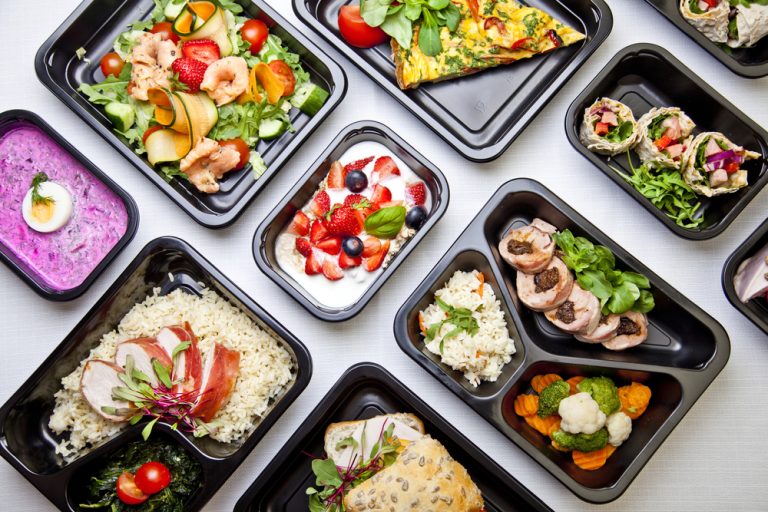
When starting a catering business, it’s essential to have a well-structured business plan in place. A comprehensive business plan not only helps you outline your goals and strategies but also serves as a detailed roadmap for success. However, creating a business plan from scratch can be a daunting task. That’s where catering business plan templates come in handy. Understand the importance of a well-devised plan for your catering venture , as it can significantly improve your chances of overcoming challenges and achieving long-term success.
Once you’ve found a suitable template, the next step is to customize it to fit your unique catering business. This involves filling in the specific details of your business, such as your target market, menu offerings, pricing, marketing strategies, and financial projections. Customizing key elements of the template allows you to tailor it to your specific goals and vision, ensuring that your business plan accurately reflects catering businesses. Understanding the challenges that come with taking on the catering industry, developing a strategy through a tailored catering service business plan from the onset can significantly influence your path towards achieving long-term success and stability.
Why Creating a Catering Business Plan is Essential
In the catering industry, having a well-thought-out business plan is crucial for success. It provides a roadmap for your business and helps you make informed decisions. Here are some key reasons why creating a catering services business plan is essential:
Defining Your Goals: A business plan allows you to clearly define your goals and objectives. It helps you identify what you want to achieve with your catering business.
Understanding Your Target Market: By conducting market research and analysis, you can gain valuable insights into your target market. This information will help you tailor your services to meet the needs and preferences of your customers.
Outlining Strategies: Your business plan serves as a guide to outline the strategies you will implement to achieve profitability. It includes details on your menu, pricing, marketing tactics, and financial projections.
Setting Yourself Up for Success: By carefully considering all aspects of your business and planning for potential challenges, you can set yourself up for long-term success in catering companies.
If you’re dreaming of starting your catering biz, you’re in the right place. We selected 10 catering business plan templates to help you get from daydreaming to doing. We’ve broken them down into three categories: Basic, Intermediary, and Complete, so you can find just what you need, no matter where you’re at in your catering business planning process.
Basic Catering Business Plan Templates
Template 01: the quick start guide.
This business plan template is like the fast food of business plans – quick, easy, and gets the job done. It’s perfect if you’re just getting your feet wet.

Use the Quick Start Guide Template
Template 02: The Budget Buddy
Focused on the numbers, this one helps you figure out your starting costs and financial plan for how you’ll keep the lights on.

Use the Budget Buddy Template
Template 03: The Startup Planner
This template helps you outline your business concept’s initial needs, legal structure, and pricing strategy.
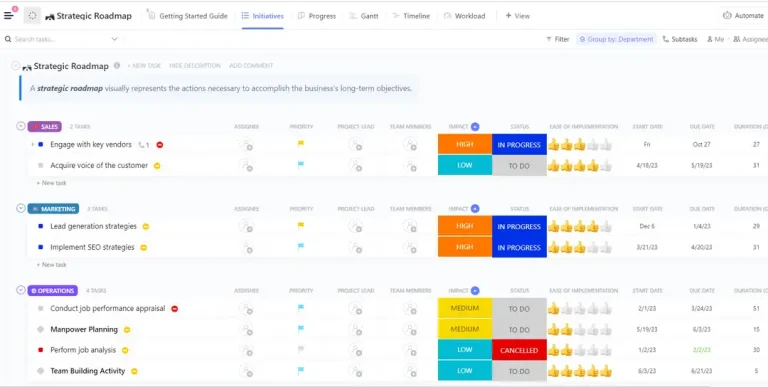
Use the Startup Planner Template
Intermediary Catering Business Plan Templates
Template 04: conscious catering strategy.
Focusing on the growing trend for healthy and dietary-specific menus, this sample menu template is perfect for caterers wanting to market and specialize in health-conscious catering industry food offerings.
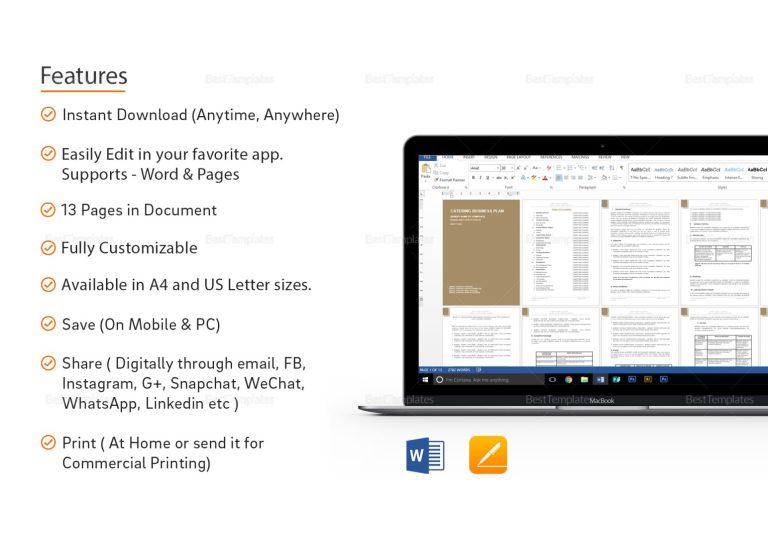
Use the Conscious Catering Strategy Template
Template 05: Full-Service Catering Plan
Designed for established catering services and catering companies ready to expand, this template focuses on operational and pricing strategies, detailed menu planning, and advanced, marketing strategies and techniques. It’s ideal for caterers looking to scale their operations and refine their service offerings. Discover strategies on constructing a lucrative catering business plan , with guidance on enhancing operations, menu selections, and marketing approaches. Visit Metrobi’s website to delve deeper.
Use the Full-Service Catering Plan Template
Template 06: Catering Growth Accelerator
Unless you’re planning to do everything yourself (spoiler: not a good idea), this template helps you plan out your dream team.
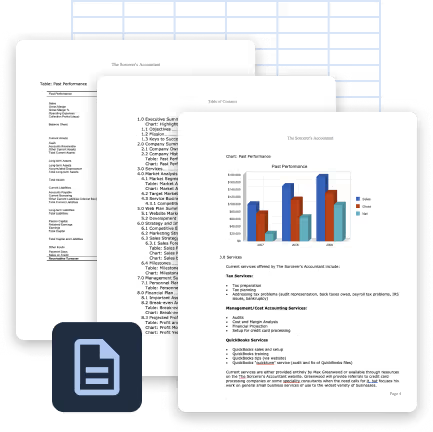
Use the Catering Growth Accelerator Template
Complete Catering Business Plan Templates
Template 07: the full feast.
This is the big one – a comprehensive marketing plan for a full catering company template that covers everything from A to Z. If you’re ready to dive deep, this is for you.

Use the Full Feast Template
Template 08: The Event Ace
Specializing in events? This template focuses on planning for different types of clients at events and managing bookings at networking events.
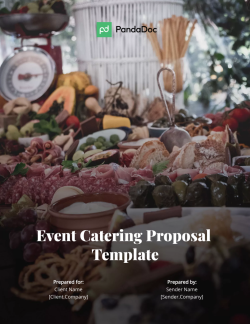
Use the Event Ace Template
Template 09: The Growth Guru
Thinking ahead? This template helps you map out marketing strategy detailed plan for how you’ll expand and grow over time.
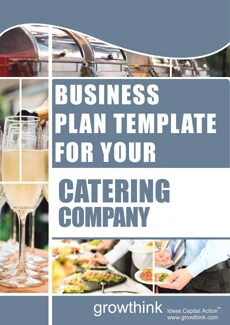
Use the Growth Guru Template
Template 10: The Risk Wrangler
Every serious business owner faces challenges. This template helps you identify potential risks to business goals and plan how to handle them.

Use the Risk Wrangler Template
Taking Action and Customizing Your Business Plan
Now is the time to take action and start creating your catering business plan. While examples and templates can be helpful starting points, it’s important to customize them to fit your unique business needs. Remember, your catering business plan template is a living document that can be updated and adjusted as your business grows and evolves. Learn how you can adapt and refine your catering business plan to ensure it aligns with your goals, enabling sustainable growth and success in the competitive catering landscape. Explore strategies to advance and update your catering business plan , positioning your venture for enduring prosperity and distinction in the bustling catering market.
Turning Your Catering Company Dreams into Reality
Starting a catering business is super exciting, but it can also be a bit overwhelming. That’s where the catering business plan template comes in. They’re like your road map to success, whether you’re just starting to sketch out your catering equipment ideas or you’re ready to launch. So, grab the first operations plan template that fits your stage and start cooking up your new catering business and plan!
Why Most Catering Businesses Fail – And How a Solid Business Plan Can Prevent It
How will your catering business plan evolve as you grow your catering business
How to Create a Profitable Catering Business Plan
‟Reliable & Consistent”
Wicked Bagel
‟My favorite drivers are there for me”
Field Trip Flowers
‟We don’t have to worry about the vehicles anymore”
Urban Agriculture Cooperative
‟We hold our drivers to a very high standard and have been pleased to see Metrobi's drivers meet those standards”
Jacobson Floral

Success Stories
Benz’s Food Products Inc.
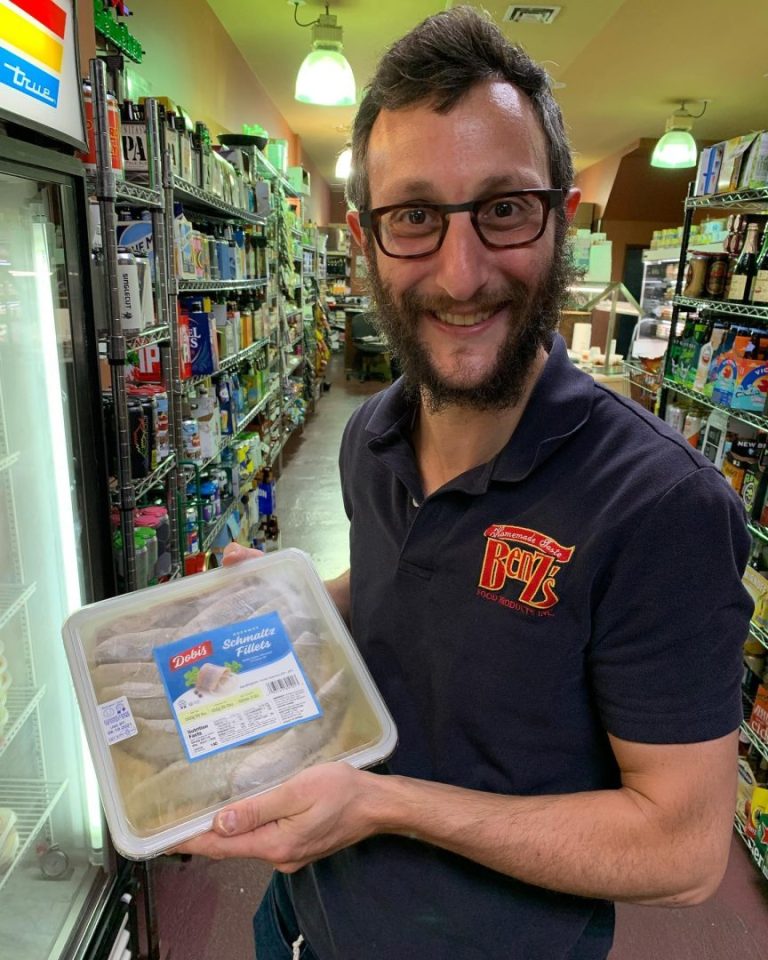
Quinlan-Wasserman

Smart Lunches

Hanato Floral Design

Anna’s Taqueria
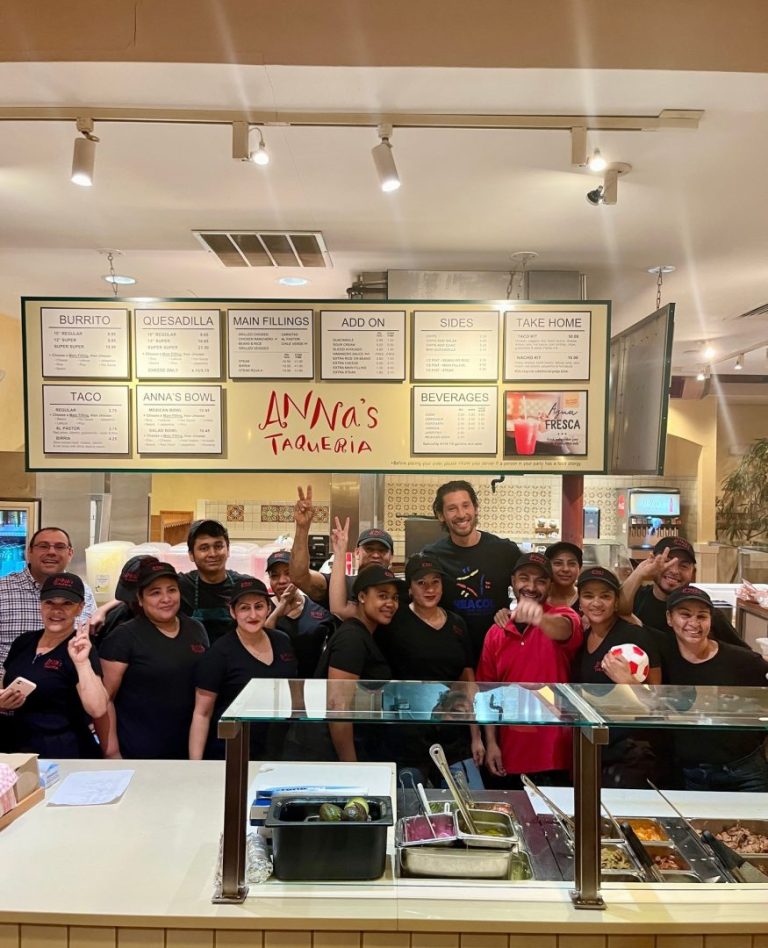
DELIVER WITH METROBI
Grow with confidence

- 55 Court St floor 2, Boston, MA 02108
- [email protected]
- Team Metrobi
- Privacy policy
- Terms of service
Refer us to a company, you earn $250 and they earn $250. Learn more
- Shopify Delivery Planner App
- Delivery Management Software
- Atlanta courier service
- Boston courier service
- Chicago courier service
- Denver courier service
- Miami courier service
- New York City courier service
- Los Angeles courier service
- Philadelphia courier service
- San Francisco courier service
- Washington DC courier service
- See all locations
- Bulk Order Delivery Service
- Express Urgent Delivery Service
- Fixed Route Delivery Service
- On Demand Delivery Service
- Overnight Delivery Service
- Same Day Delivery Service
- Scheduled Delivery Service
- Wholesale Delivery Service
- See all delivery services
- Metrobi vs. Onfleet
- Metrobi vs. Roadie
- Artisan Food
- Food Producers
Want to access our large pool of drivers?
We started Metrobi to take operations off your plate. We provide drivers (rated 4.97/5), dedicated operation managers (70% cheaper), and routing software with a receiver notification system.

Sample Catering Business Plan

Writing a business plan is a crucial step in starting a catering business. Not only does it provide structure and guidance for the future, but it also helps to create funding opportunities and attract potential investors. For aspiring catering business owners, having access to a sample catering business plan can be especially helpful in providing direction and gaining insight into how to draft their own catering business plan.
Download our Ultimate Catering Business Plan Template
Having a thorough business plan in place is critical for any successful catering venture. It will serve as the foundation for your operations, setting out the goals and objectives that will help guide your decisions and actions. A well-written business plan can give you clarity on realistic financial projections and help you secure financing from lenders or investors. A catering business plan example can be a great resource to draw upon when creating your own plan, making sure that all the key components are included in your document.
The catering business plan sample below will give you an idea of what one should look like. It is not as comprehensive and successful in raising capital for your catering as Growthink’s Ultimate Catering Business Plan Template , but it can help you write a catering business plan of your own.
Example – SavorFest Caterers
Table of contents, executive summary, company overview, industry analysis, customer analysis, competitive analysis, marketing plan, operations plan, management team, financial plan.
At SavorFest Caterers, located in the vibrant city of Austin, TX, we are passionately committed to delivering unparalleled catering services that truly distinguish us in a competitive marketplace. Our philosophy revolves around the belief that the essence of a memorable event is not just the quality of food but also the caliber of service provided. To this end, our team is rigorously trained to execute seamless events, complemented by our meticulously prepared dishes that utilize only the finest ingredients. This dedication to excellence ensures a culinary experience that exceeds the expectations of the most discerning guests. Furthermore, our continuous innovation in offering tailored catering solutions allows us to meet the varied needs of our clients, making every event uniquely unforgettable.
Our success hinges on our unwavering commitment to quality and innovation, which has been instrumental in distinguishing SavorFest Caterers within the bustling Austin catering scene. We’ve achieved this through our dedication to sourcing the finest ingredients, our flexibility in customizing our services to meet the diverse needs of our clientele, and our relentless pursuit of excellence in both food and service. These factors, combined with our ability to adapt to any event theme or dietary requirement, position us as the go-to caterers for those seeking an incomparable dining experience.
The catering industry, while competitive, presents substantial opportunities for businesses that can distinguish themselves through exceptional service and culinary innovation. This is particularly true in markets like Austin, TX, where the demand for high-quality catering services is driven by a vibrant cultural scene and a growing economy. Success in this industry demands not just culinary excellence but also the ability to adapt to evolving consumer preferences and dietary needs. Companies that can leverage local ingredients and offer personalized experiences stand a better chance of capturing and retaining a loyal customer base.
Our target customers are diverse, ranging from individuals and families celebrating special occasions to businesses and organizations hosting corporate events. These clients are united by a common desire for high-quality, memorable catering experiences that are tailored to their specific needs. They value creativity, flexibility, and attention to detail, and they are willing to invest in premium services that meet these criteria. Catering to such a varied clientele requires a deep understanding of different dietary preferences and event formats, something we excel in at SavorFest Caterers.
Top Competitors: Gourmet Delights, EliteEats Catering, and Feast & Festivities
Gourmet Delights is known for its traditional gourmet offerings, while EliteEats Catering focuses on corporate events with a modern twist. Feast & Festivities targets weddings and large social gatherings with their extensive buffet options. Our competitive advantage lies in our personalized approach, our commitment to quality and innovation, and our versatility in catering to any event theme or dietary requirement, setting us apart as the preferred choice for a wide range of clients.
Our marketing plan is centered around showcasing our diverse range of products, services, and competitive pricing. We offer a wide selection of menu options that cater to various dietary needs and event types, from intimate gatherings to large-scale corporate events. Our pricing strategy is designed to offer value to our clients, ensuring they receive the highest quality service and culinary excellence at competitive prices. To promote our services, we leverage a multi-channel approach that includes social media marketing, targeted email campaigns, and strategic partnerships with event planners and venues. Our promotions plan is focused on building brand awareness and driving engagement through special offers, tastings, and participation in local events, which allows us to connect directly with potential customers and showcase our culinary expertise.
Our operations are the backbone of our success, encompassing menu planning, ingredient sourcing, inventory management, and more. We prioritize sourcing high-quality, fresh ingredients locally, supporting the community and ensuring the best taste. Our inventory is meticulously managed to prevent shortages and reduce waste. The order process is streamlined for customer convenience, and our food preparation adheres to strict quality control standards. Compliance with health and safety regulations is paramount, ensuring a safe environment for both staff and customers. We also focus on exceptional customer service and communication, essential for customer satisfaction and retention. Logistics for event catering are carefully coordinated, ensuring timely setup, service, and cleanup. Our marketing efforts and customer relationship management are ongoing, aimed at attracting new customers and fostering loyalty among existing ones. Financial management is handled with diligence, monitoring daily revenues and expenses to maintain healthy cash flow and inform strategic decisions.
Our management team comprises experienced professionals with a passion for catering and event management. Each member brings a unique set of skills and expertise to the table, from culinary arts to business administration and customer service. This diversity in our leadership ensures a comprehensive approach to managing all aspects of the business, from menu development and event planning to marketing and financial management. Together, we are committed to upholding the highest standards of quality and innovation, driving SavorFest Caterers towards continued success and growth.
Welcome to SavorFest Caterers, a fresh and vibrant catering service now gracing the Austin, TX scene. As a local catering business, we pride ourselves on filling a much-needed gap in the market. Until now, the area has seen a lack of high-quality local catering services, a void we’re excited to fill with our unique blend of culinary expertise and passionate service.
At SavorFest Caterers, our offerings are designed with versatility and quality in mind. Our services span the entire spectrum of catering needs, from intimate events to grand celebrations. Clients can look forward to customizable menus that cater to a wide array of dietary preferences and event themes. Beyond exceptional food, our services extend to food delivery and setup, ensuring every event is executed flawlessly. We also provide comprehensive beverage services, complemented by our team of professional staff who are committed to making every occasion memorable.
Rooted in the heart of Austin, TX, SavorFest Caterers is poised to serve the local community and its diverse clientele. Our location not only allows us to be at the center of Austin’s vibrant event scene but also enables us to source fresh ingredients from local suppliers, supporting the community we are a part of.
Our confidence in our success is not unfounded. The founding team brings with it a wealth of experience from running a successful catering business previously. This, combined with our commitment to offering superior catering services and meticulously prepared food and beverages, sets us apart from our competition. Our dedication to excellence in every aspect of our service ensures that SavorFest Caterers stands out as the premier choice for catering in Austin.
Since our inception on January 6, 2024, as a Sole Proprietorship, we’ve hit the ground running. Our accomplishments to date include the creation of a distinctive logo that captures the essence of our brand, the development of our unique company name that resonates with our mission, and securing a prime location that serves as our operating base. These achievements mark the beginning of our journey to becoming a cornerstone of the Austin catering scene.
The Catering industry in the United States is a thriving and lucrative market. According to industry reports, the current size of the market is estimated to be around $60 billion. This indicates a strong demand for catering services and presents significant opportunities for growth and profitability.
Furthermore, the Catering industry is expected to experience steady growth in the coming years. Market research suggests that the industry is projected to grow at a CAGR of approximately 4% over the next five years. This growth can be attributed to various factors including increasing consumer spending, rising disposable incomes, and a growing preference for convenience and personalized dining experiences.
These trends in the Catering industry are particularly promising for SavorFest Caterers, a new catering business operating in Austin, TX. As consumers increasingly seek out unique and memorable dining experiences, SavorFest Caterers is well-positioned to capitalize on this demand. With its commitment to delivering exceptional service, innovative menus, and attention to detail, SavorFest Caterers has the potential to carve out a significant market share in the Austin catering scene and establish itself as a go-to choice for customers seeking high-quality catering services.
Below is a description of our target customers and their core needs.
Target Customers
SavorFest Caterers will target local residents eager to add an extraordinary touch to their private gatherings, from intimate family reunions to larger celebratory events. These customers are looking for high-quality, memorable culinary experiences that reflect the unique flavors and spirit of Austin, TX. SavorFest Caterers will tailor its offerings to meet the diverse tastes and dietary preferences of this vibrant community, ensuring every event is a reflection of its host’s distinct style and personality.
Aside from serving local residents, SavorFest Caterers will also cater to the business sector, including corporate events, conferences, and office parties. Austin’s dynamic business environment, characterized by a mix of startups, tech companies, and established firms, presents a lucrative opportunity for SavorFest Caterers. The company will offer customizable menus and flexible service options to accommodate the specific needs and schedules of business clients, aiming to become a trusted partner for companies seeking to enhance their corporate events.
Furthermore, SavorFest Caterers will target the thriving event industry in Austin, including weddings, festivals, and public gatherings. This segment demands exceptional catering services that can handle the scale and specific requirements of such events, from outdoor weddings to large-scale public festivals. SavorFest Caterers will leverage its expertise and creativity to provide standout culinary experiences that contribute to the success and memorability of these events, establishing itself as a go-to caterer for Austin’s event planners and organizers.
Customer Needs
SavorFest Caterers emerges as a beacon of culinary excellence, poised to meet the sophisticated needs of Austin’s residents who desire professional catering services. These discerning clients expect not just meals but culinary experiences that tantalize the taste buds and elevate their events. SavorFest Caterers can fulfill this need by offering a diverse menu that incorporates both local flavors and international cuisines, ensuring a unique dining experience for every occasion.
Moreover, SavorFest Caterers understands the importance of seamless service in event planning. Clients can count on meticulous attention to detail, from the presentation of food to the professionalism of the staff. This reliability ensures that hosts can focus on their guests, confident in the knowledge that all catering aspects are expertly managed. SavorFest Caterers thus not only satisfies the appetite but also contributes to the overall success and ambiance of the event.
In addition to exceptional food and service, SavorFest Caterers recognizes the growing demand for sustainable and health-conscious catering options. By incorporating organic, locally-sourced ingredients and offering a range of dietary accommodations, SavorFest can cater to the diverse preferences and needs of Austin’s residents. This commitment to quality and sustainability further distinguishes SavorFest Caterers as a versatile and conscientious choice for any event, large or small.
WheelsJourney Rentals’s competitors include the following companies:
Alamo Rent A Car offers a range of services including economy cars, SUVs, and luxury vehicles for both leisure and business travelers. Their price points vary depending on vehicle type, rental duration, and location but are competitive within the industry. Alamo generates significant revenue from both domestic and international travelers, thanks to its presence in major airports across the United States and in several other countries. Alamo serves a wide customer segment including individual travelers, families, and business professionals. They operate in numerous geographies including the United States, Canada, Mexico, Europe, Australia, and South America. A key strength of Alamo is their self-service kiosks that expedite the rental process for customers. However, a potential weakness is their reliance on airport locations, which may limit their reach to local renters who prefer more accessible city or neighborhood locations.
Enterprise Rent-A-Car offers a broad spectrum of vehicles including cars, trucks, and vans to cater to a variety of customer needs. Their pricing is flexible, with options for daily, weekly, and long-term rentals, often including deals and discounts for certain customer segments. Enterprise boasts substantial revenues, underpinned by a strong brand and extensive network of locations. Enterprise targets a diverse customer base from individual renters to large corporations requiring fleet services. The company has a vast geographical presence, operating not just in the United States but also in Europe, Canada, Asia, and beyond. One of Enterprise’s key strengths is its customer service, often recognized as industry-leading. However, its size and scope can sometimes lead to inconsistencies in service quality across different locations.
Rose Caterings might not have the same level of brand recognition as Alamo or Enterprise but offers competitive products and services in select markets. Their vehicle offerings include standard cars, luxury models, and specialty vehicles. Rose Caterings’ pricing strategy aims to attract budget-conscious consumers with competitive rates and transparent fees. Rose Caterings primarily serves customers in urban and suburban areas, focusing on convenience and personalized service. They operate in a limited geographical area but are looking to expand their presence. A strength of Rose Caterings is their focus on customer satisfaction and local market expertise. However, their limited geographical reach and smaller fleet size compared to larger competitors could be seen as weaknesses.
Competitive Advantages
At SavorFest Caterers, we pride ourselves on offering superior catering services that stand out in the competitive Austin, TX market. Our dedication to excellence is evident in every dish we serve, setting us apart from our competitors. We understand that the key to a memorable event lies not only in the quality of food but also in the service provided. Therefore, we ensure that our team is trained to offer impeccable service, making every event a seamless experience. Our carefully prepared food and beverages reflect our commitment to quality, using only the finest ingredients to create culinary delights that satisfy even the most discerning palates.
Moreover, our competitive advantage extends beyond our exceptional food and service. We are constantly innovating, offering unique and personalized catering solutions to meet the diverse needs of our clients. Whether it’s a small family gathering or a large corporate event, we tailor our services to ensure that each occasion is unforgettable. Our flexibility and attention to detail mean that we can adapt to any theme or dietary requirement, making us the preferred choice for customers seeking a caterer that can truly cater to their specific needs. By choosing SavorFest Caterers, clients can expect not just a meal, but an extraordinary dining experience that will leave a lasting impression on their guests.
Our marketing plan, included below, details our products/services, pricing and promotions plan.
Products and Services
SavorFest Caterers emerges as a beacon of culinary excellence, offering a diverse range of services tailored to meet the unique needs of each event. At the heart of their offerings is Catering Services for Events, which stands as a testament to their commitment to delivering unforgettable dining experiences. Clients can expect to engage in a collaborative process, working closely with the SavorFest team to design a menu that perfectly aligns with the theme and expectations of their event. The average cost for these comprehensive catering services starts at $50 per person, ensuring a balance of quality and value.
Understanding the importance of personal touch and customization, SavorFest Caterers introduces Customizable Menus as one of its key services. This offering allows clients to tailor their event’s culinary journey, ensuring that every dish reflects their personal taste and dietary preferences. Whether it’s a wedding, corporate gathering, or intimate dinner party, the ability to customize menus adds a layer of exclusivity and personalization to every occasion. Prices for customizable menus are variable, starting at an additional $10 per person on top of the base catering service cost, depending on the complexity and ingredients required.
With an eye for convenience and efficiency, SavorFest Caterers also provides Food Delivery and Setup services. This offering is designed to ensure that every aspect of the event’s culinary needs is handled with care and professionalism, from the careful delivery of prepared dishes to the meticulous setup at the venue. Clients can expect this service to start at $200, varying with the size and location of the event, providing a hassle-free solution to event planning and execution.
Beverage Services complement the culinary offerings, providing a curated selection of drinks to match the quality and theme of the food served. From artisanal cocktails to fine wines and refreshing non-alcoholic options, SavorFest ensures that every guest finds a beverage that suits their taste. This service is priced starting at $15 per person, offering a range of options to suit various preferences and budgets.
Professional Staffing stands as a cornerstone of SavorFest Caterers’ commitment to excellence. Recognizing that the success of an event often hinges on the quality of service, SavorFest provides skilled and courteous staff for every occasion. Whether it’s chefs, servers, or bartenders, clients can expect professionalism and efficiency, ensuring that every guest’s needs are attended to. The cost for professional staffing starts at $30 per hour per staff member, contributing to a seamless and memorable event experience.
Through these diverse offerings, SavorFest Caterers positions itself as a premier choice for those seeking exceptional catering services in Austin, TX. With a focus on quality, customization, and client satisfaction, they are dedicated to making every event a remarkable culinary journey.
Promotions Plan
WheelsJourney Rentals employs a variety of promotional methods and tactics to attract customers in Dallas, TX. Online marketing stands at the forefront of these efforts, leveraging the power of social media platforms, search engine optimization (SEO), and targeted email campaigns. By engaging potential customers where they spend a significant portion of their time, WheelsJourney Rentals ensures its visibility and relevance in a competitive market.
In addition to online marketing, WheelsJourney Rentals also utilizes traditional advertising methods such as billboards and local radio ads. These mediums offer broad exposure, helping to build brand recognition and trust within the community. Furthermore, partnerships with local businesses and tourism agencies will play a crucial role in cross-promotion, reaching an audience that is already interested in travel and vehicle rental services.
Customer referral programs are another key tactic in WheelsJourney Rentals’ promotional strategy. By incentivizing current customers to refer friends and family, the company taps into the power of word-of-mouth marketing. This not only increases the customer base but also strengthens customer loyalty, as people tend to trust recommendations from people they know.
Loyalty programs will also be implemented to encourage repeat business. These programs reward customers for their continued patronage, offering discounts, special offers, and exclusive benefits. This approach not only fosters a loyal customer base but also differentiates WheelsJourney Rentals from its competitors.
Lastly, attending and sponsoring local events and exhibitions will raise the profile of WheelsJourney Rentals. Participation in such events demonstrates the company’s commitment to the community and allows for direct engagement with potential customers. It provides an excellent opportunity to showcase the range of services and the quality of vehicles offered, creating a lasting impression on event attendees.
By employing these promotional methods and tactics, WheelsJourney Rentals expects to attract a wide range of customers in Dallas, TX. The combination of online and traditional marketing, alongside customer engagement programs, ensures that WheelsJourney Rentals remains competitive and becomes a preferred choice for vehicle rental services.
Our Operations Plan details:
- The key day-to-day processes that our business performs to serve our customers
- The key business milestones that our company expects to accomplish as we grow
Key Operational Processes
To ensure the success of SavorFest Caterers, there are several key day-to-day operational processes that we will perform.
- Constantly update and adapt menus to meet customer preferences and seasonal availability of ingredients.
- Source high-quality, fresh ingredients from local suppliers to ensure the best taste and support the local economy.
- Maintain an accurate inventory of ingredients, supplies, and equipment to avoid shortages or excess.
- Implement a first-in, first-out (FIFO) system to ensure freshness and reduce waste.
- Ensure a seamless order intake process, utilizing online and phone-based systems for customer convenience.
- Confirm orders with customers, including specific details such as date, time, location, and any special requests.
- Prepare dishes according to established recipes and presentation standards to ensure consistency and quality.
- Conduct regular quality control checks throughout the food preparation process.
- Adhere strictly to health and safety regulations to ensure a safe environment for both staff and customers.
- Regularly train staff on the latest health and safety practices and conduct frequent audits.
- Provide excellent customer service, addressing any inquiries or concerns promptly and professionally.
- Maintain open lines of communication with customers before, during, and after events to ensure satisfaction.
- Coordinate logistics for event catering, including transportation of food, equipment, and staff to and from event locations.
- Ensure timely setup, service, and cleanup at events, adhering to the agreed schedule.
- Engage in ongoing marketing efforts to attract new customers and retain existing ones, utilizing social media, email marketing, and word-of-mouth.
- Use CRM tools to manage customer data, feedback, and communication to personalize service and foster loyalty.
- Monitor daily revenues and expenses to manage cash flow effectively.
- Prepare and review financial reports regularly to inform strategic decision-making.
SavorFest Caterers expects to complete the following milestones in the coming months in order to ensure its success:
- Launch Our Catering Business : This is the foundational milestone that involves setting up the operational structure, finalizing the menu, establishing a base kitchen, and initiating marketing campaigns to create awareness in the Austin area.
- Obtain Necessary Permits and Licenses : Secure all required local, state, and possibly federal permits and licenses to legally operate a catering business in Austin, TX. This includes health department permits, a food handler’s license, and a business license.
- Build a Robust Vendor Network : Establish relationships with local food suppliers, equipment rental companies, and event venues to ensure quality, reliability, and cost-effectiveness in service delivery.
- Hire and Train Staff : Recruit a team of chefs, servers, and support staff. Provide comprehensive training on food safety, customer service, and company policies to ensure high-quality service delivery.
- Implement an Online Ordering and Management System : Set up a user-friendly online platform for customers to view the menu, place orders, and make payments. This system should also facilitate efficient order management, scheduling, and customer communication.
- Secure First 10 Contracts : Aim to secure contracts for 10 events (could be weddings, corporate events, private parties, etc.) as a proof of concept and to build a portfolio of successful events.
- Achieve Consistent Positive Customer Feedback : Establish a system for collecting and analyzing customer feedback. Aim for high satisfaction rates to build a strong reputation in the Austin catering market.
- Reach $5,000/Month in Revenue : This intermediate financial milestone indicates initial market acceptance and will help in refining the business model towards profitability.
- Form Strategic Partnerships : Establish partnerships with event planners, venues, and other related businesses in Austin to create referral opportunities and expand the customer base.
- Get to $15,000/Month in Revenue : Achieving this milestone within 24 months will indicate strong market demand, operational efficiency, and a path towards long-term sustainability and growth for SavorFest Caterers.
SavorFest Caterers management team, which includes the following members, has the experience and expertise to successfully execute on our business plan:
Noah Wilson, CEO
Noah Wilson brings a wealth of experience to SavorFest Caterers, marked by a proven track record of success in the catering industry. His previous endeavor as the head of a catering business laid the foundation for his deep understanding of the complexities of the catering world, from menu selection and event planning to logistics and customer service. Noah’s leadership is defined by his ability to foresee industry trends, adapt to changing market demands, and inspire his team to strive for excellence. His strategic vision and hands-on experience are crucial assets for SavorFest Caterers, positioning the company for sustained growth and success in a competitive market.
To achieve our growth objectives, we are seeking to raise funds that will be strategically invested in expanding our service offerings, enhancing our marketing efforts, and improving our operational infrastructure. This financial injection will enable us to fulfill our growth potential, capture a larger market share, and ultimately establish SavorFest Caterers as a leader in the catering industry. Our detailed financial plan outlines the required investment and the projected returns, demonstrating our commitment to creating value for our stakeholders while delivering exceptional catering experiences to our clients.
Financial Statements
Balance sheet.
[insert balance sheet]
Income Statement
[insert income statement]
Cash Flow Statement
[insert cash flow statement]
Catering Business Plan Example PDF
Download our Catering Business Plan PDF here. This is a free catering business plan example to help you get started on your own catering plan.
How to Finish Your Catering Business Plan in 1 Day!
Don’t you wish there was a faster, easier way to finish your catering business plan?
With Growthink’s Ultimate Business Plan Template you can finish your plan in just 8 hours or less!

Catering Business Plan Template & Guidebook
Starting a catering business can be an incredibly rewarding venture, offering flexibility, creativity, and a unique opportunity to express your culinary prowess. To ensure your business venture is successful, it's important to create a comprehensive business plan. Fortunately, our Catering Business Plan Template & Guidebook is here to provide you with the most up-to-date information and resources you need to make your venture a reality. This comprehensive guide will walk you through each step of the process and provide invaluable advice on how to develop an effective business plan for your catering business.

Get worry-free services and support to launch your business starting at $0 plus state fees.
- How to Start a Profitable Catering Business [11 Steps]
- 10+ Best & Profitable Catering Business Ideas [2023]
- 25 Catchy Catering Business Names:
- List of the Best Marketing Ideas For Your Catering Service:
How to Write a Catering Business Plan in 7 Steps:
1. describe the purpose of your catering business..
The first step to writing your business plan is to describe the purpose of your catering business. This includes describing why you are starting this type of business, and what problems it will solve for customers. This is a quick way to get your mind thinking about the customers’ problems. It also helps you identify what makes your business different from others in its industry.
It also helps to include a vision statement so that readers can understand what type of company you want to build.
Here is an example of a purpose mission statement for a catering business:
Our mission at ABC Catering is to create delicious, custom-made culinary experiences that bring joy, satisfaction, and lasting memories to each and every one of our clients. We are dedicated to providing outstanding customer service and creating unforgettable, high-quality catering experiences that will leave all of our guests delighted.

2. Products & Services Offered by Your Catering Business.
The next step is to outline your products and services for your catering business.
When you think about the products and services that you offer, it's helpful to ask yourself the following questions:
- What is my business?
- What are the products and/or services that I offer?
- Why am I offering these particular products and/or services?
- How do I differentiate myself from competitors with similar offerings?
- How will I market my products and services?
You may want to do a comparison of your business plan against those of other competitors in the area, or even with online reviews. This way, you can find out what people like about them and what they don’t like, so that you can either improve upon their offerings or avoid doing so altogether.

3. Build a Creative Marketing Stratgey.
If you don't have a marketing plan for your catering business, it's time to write one. Your marketing plan should be part of your business plan and be a roadmap to your goals.
A good marketing plan for your catering business includes the following elements:
Target market
- Who is your target market?
- What do these customers have in common?
- How many of them are there?
- How can you best reach them with your message or product?
Customer base
- Who are your current customers?
- Where did they come from (i.e., referrals)?
- How can their experience with your catering business help make them repeat customers, consumers, visitors, subscribers, or advocates for other people in their network or industry who might also benefit from using this service, product, or brand?
Product or service description
- How does it work, what features does it have, and what are its benefits?
- Can anyone use this product or service regardless of age or gender?
- Can anyone visually see themselves using this product or service?
- How will they feel when they do so? If so, how long will the feeling last after purchasing (or trying) the product/service for the first time?
Competitive analysis
- Which companies are competing with yours today (and why)?
- Which ones may enter into competition with yours tomorrow if they find out about it now through word-of-mouth advertising; social media networks; friends' recommendations; etc.)
- What specific advantages does each competitor offer over yours currently?
Marketing channels
- Which marketing channel do you intend to leverage to attract new customers?
- What is your estimated marketing budget needed?
- What is the projected cost to acquire a new customer?
- How many of your customers do you instead will return?
Form an LLC in your state!

4. Write Your Operational Plan.
Next, you'll need to build your operational plan. This section describes the type of business you'll be running, and includes the steps involved in your operations.
In it, you should list:
- The equipment and facilities needed
- Who will be involved in the business (employees, contractors)
- Financial requirements for each step
- Milestones & KPIs
- Location of your business
- Zoning & permits required for the business
What equipment, supplies, or permits are needed to run a catering business?
To run a catering business, you will need the following equipment and supplies:
- Commercial kitchen space or access to a commercial kitchen
- Cooking vessels of various sizes
- Industrial-grade ovens and stoves
- Freezer and refrigeration units
- Utensils for cooking and serving, such as tongs, spoons, and knives
- Serving trays or platters
- Food packaging materials
- Pots, pans, hot plates and other cooking equipment
- Food safety supplies such as thermometers and gloves
- Transportation vehicles
You may also need the following permits:
- Licenses for selling food in your area
- Health permit to serve food in your area
- Catering license or permit if required by your state/local government.
5. Management & Organization of Your Catering Business.
The second part of your catering business plan is to develop a management and organization section.
This section will cover all of the following:
- How many employees you need in order to run your catering business. This should include the roles they will play (for example, one person may be responsible for managing administrative duties while another might be in charge of customer service).
- The structure of your management team. The higher-ups like yourself should be able to delegate tasks through lower-level managers who are directly responsible for their given department (inventory and sales, etc.).
- How you’re going to make sure that everyone on board is doing their job well. You’ll want check-ins with employees regularly so they have time to ask questions or voice concerns if needed; this also gives you time to offer support where necessary while staying informed on how things are going within individual departments too!
6. Catering Business Startup Expenses & Captial Needed.
This section should be broken down by month and year. If you are still in the planning stage of your business, it may be helpful to estimate how much money will be needed each month until you reach profitability.
Typically, expenses for your business can be broken into a few basic categories:
Startup Costs
Startup costs are typically the first expenses you will incur when beginning an enterprise. These include legal fees, accounting expenses, and other costs associated with getting your business off the ground. The amount of money needed to start a catering business varies based on many different variables, but below are a few different types of startup costs for a catering business.
Running & Operating Costs
Running costs refer to ongoing expenses related directly with operating your business over time like electricity bills or salaries paid out each month. These types of expenses will vary greatly depending on multiple variables such as location, team size, utility costs, etc.
Marketing & Sales Expenses
You should include any costs associated with marketing and sales, such as advertising and promotions, website design or maintenance. Also, consider any additional expenses that may be incurred if you decide to launch a new product or service line. For example, if your catering business has an existing website that needs an upgrade in order to sell more products or services, then this should be listed here.
7. Financial Plan & Projections
A financial plan is an important part of any business plan, as it outlines how the business will generate revenue and profit, and how it will use that profit to grow and sustain itself. To devise a financial plan for your catering business, you will need to consider a number of factors, including your start-up costs, operating costs, projected revenue, and expenses.
Here are some steps you can follow to devise a financial plan for your catering business plan:
- Determine your start-up costs: This will include the cost of purchasing or leasing the space where you will operate your business, as well as the cost of buying or leasing any equipment or supplies that you need to start the business.
- Estimate your operating costs: Operating costs will include utilities, such as electricity, gas, and water, as well as labor costs for employees, if any, and the cost of purchasing any materials or supplies that you will need to run your business.
- Project your revenue: To project your revenue, you will need to consider the number of customers you expect to have and the average amount they will spend on each visit. You can use this information to estimate how much money you will make from selling your products or services.
- Estimate your expenses: In addition to your operating costs, you will need to consider other expenses, such as insurance, marketing, and maintenance. You will also need to set aside money for taxes and other fees.
- Create a budget: Once you have estimated your start-up costs, operating costs, revenue, and expenses, you can use this information to create a budget for your business. This will help you to see how much money you will need to start the business, and how much profit you can expect to make.
- Develop a plan for using your profit: Finally, you will need to decide how you will use your profit to grow and sustain your business. This might include investing in new equipment, expanding the business, or saving for a rainy day.
Frequently Asked Questions About Catering Business Plans:
Why do you need a business plan for a catering business.
A business plan for a catering business is necessary because it sets out goals, objectives, and strategies that provide direction to the business. It also acts as a roadmap for the business, allowing the owners and stakeholders to track progress. Additionally, potential investors or lenders may require a business plan before investing in or lending to the catering business. A well-written business plan can serve as an essential document for securing capital and launching a successful catering operation.
Who should you ask for help with your catering business plan?
It is recommended to consult with a professional business consultant or adviser with expertise in the catering industry. Additionally, local Small Business Development Centers (SBDCs) often provide free or low-cost guidance and advice on creating a business plan.
Can you write a catering business plan yourself?
Writing a catering business plan is possible to do on your own, however it is best to seek the advice of a professional who has experience in crafting and managing business plans for small businesses. A professional can provide the help you need to make sure the plan is comprehensive and tailored to your business’s unique needs. They can also ensure that the plan meets all legal requirements and fits within the local regulatory framework. Additionally, they can provide guidance on marketing, pricing, budgeting, and other business operations issues.
Related Business Plans

Home Inventory Business Plan Template & Guidebook

Home Inspection Business Plan Template & Guidebook

Home Decor Business Plan Template & Guidebook

Health And Wellness Business Plan Template & Guidebook

Hauling Business Plan Template & Guidebook

Hardware Business Plan Template & Guidebook

Handyman Business Plan Template & Guidebook

Hair Extension Business Plan Template & Guidebook

Handbag Business Plan Template & Guidebook
I'm Nick, co-founder of newfoundr.com, dedicated to helping aspiring entrepreneurs succeed. As a small business owner with over five years of experience, I have garnered valuable knowledge and insights across a diverse range of industries. My passion for entrepreneurship drives me to share my expertise with aspiring entrepreneurs, empowering them to turn their business dreams into reality.
Through meticulous research and firsthand experience, I uncover the essential steps, software, tools, and costs associated with launching and maintaining a successful business. By demystifying the complexities of entrepreneurship, I provide the guidance and support needed for others to embark on their journey with confidence.
From assessing market viability and formulating business plans to selecting the right technology and navigating the financial landscape, I am dedicated to helping fellow entrepreneurs overcome challenges and unlock their full potential. As a steadfast advocate for small business success, my mission is to pave the way for a new generation of innovative and driven entrepreneurs who are ready to make their mark on the world.
Don't bother with copy and paste.
Get this complete sample business plan as a free text document.
Catering Business Plan
Start your own catering business plan
Bright Future Youth and Family Services
Executive summary executive summary is a brief introduction to your business plan. it describes your business, the problem that it solves, your target market, and financial highlights.">, opportunity.
Society lacks resources for the less privileged or homeless youth population. Eugene, like all the other cities, has a migration of homeless teenagers who have run away from home. They are here for a few months of the year and then they hitch down to California during the winter for warmer weather. These are young adults who have no idea how to be part of society. They can’t provide for themselves and eventually they have children and the cycle continues.
We provide at-risk youth alternative education and career assistance in Lane County. We want to make this experience valuable for our clients. We do this through a series of curricula funded by the Lane Workforce Partnership, Oregon Youth Conservation Corps, Oregon Department of Human Resources, and the local school districts.
Our most recent program is a culinary arts program in which students learn about food preparation and safe handling and then put this knowledge to use by preparing lunches for their peers at the Chambers School. After completing the 9-week curriculum, students are placed with a local food service business for a 60-hour practical training where they can continue to develop their skills. Currently, the culinary arts program is available to five students per 9-week school term, or approximately 25 students per year. Students enrolled in the program are selected because of their sincere interest in the culinary field and their excellent attendance.
According to the Eugene Area Chamber of Commerce, “[a]t the heart of the Eugene economy are the homegrown small and medium-sized businesses. Most of Eugene’s businesses employ fewer than 20 workers. From specialty retail shops to financial service firms, from management consultancies to ethnic groceries, Eugene’s small business community is diverse, active, thriving and well-supported. Including sole proprietorships and limited partnerships, there are more than 10,000 businesses in and around Eugene.” Eugene/Springfield’s population has grown 3.95% on average since 1998 and this new growth has meant new businesses and expanding opportunities for catering companies who can serve these businesses’ needs.
Catering For Kids anticipates that Eugene/Springfield businesses have unmet demand for catered lunch meetings and other events. And unlike other restaurant and food-related businesses, business to business catering is not as cyclical as business to consumer catering. Businesses continue to have lunch meetings and employees who wish to purchase their lunches year round. In order to gain some insight into the market size and demand, we undertook some limited market research. An email survey was sent to 144 Lane County nonprofit organizations that requested their current or future demand for catering services and their interest in patronizing a nonprofit catering business. We received many responses like the ones that follow.
“I think that this is a great idea and could be a good resource for the community. Springfield/Eugene Habitat for Humanity does not host many lunchtime meetings, however there is a group of about 13 or 14 Executive Directors of Habitat affiliates that meet here about every three months that might use your service.” – Susan Brown, Volunteer Coordinator, Eugene/Springfield Habitat for Humanity
“…if we do have an event that we need catering we will call your program first. We have a policy of using nonprofit organizations for services first.” – Bob Smith, Exec Dir, Pacific Youth Corps of Oregon
“Our needs for catering are not very large, maybe a few times a year. However, you may contact me to discuss the program. My son attends Chambers School and I would welcome hearing more details.” – Mark West, Lane County Agricultural Museum
“We do have General Membership Meetings where we require a venue for 50 to 100 people. I’m not involved with arranging the meetings but do know that our organization is in need of a place to meet where food and beer can be served. Perhaps you will hear from Dave – I think the first meeting is usually in October.” – Emily, Graduate Teaching Federation Office
Competition
A number of other caterers offer boxed lunches for business clients. However, none of these businesses specialize in serving the nonprofit sector, nor are they themselves a nonprofit that benefits the local community. Catering For Kids will specialize in developing excellent relationships with its nonprofit clientele. We believe that this unique position, combined with competitively priced, fresh, high-quality meals will set Catering For Kids apart as the premier caterer for the Lane County nonprofit sector.
Catering For Kids is dedicated to providing at-risk youth with an opportunity to gain work experience and transferable skills by providing our customers with healthy, homemade foods and excellent service at reasonable prices. Employees of Catering For Kids will be students who are enrolled in the culinary arts program at the Chambers School and Career Center and are interested in gaining work experience in the restaurant and food services industry. The experiences the students have while participating in this program will assist them in making the transition from school to work and will allow them to develop entrepreneurial skills that will be transferable to any job in the future.
Expectations
The following benchmark chart indicates our key financial indicators for the first three years. We foresee slow but steady growth in demand for our services and consequent increase in operating expenses. During year one, Catering For Kids will serve its internal market only, as we ramp up to serving the external market in year two.
Financial Highlights by Year
Financing needed.
One of our revenue lines is grant funding, $15,000 annually. And we need and anticipate donations of $2,000 per month, plus some revenue from fees for lunches and event catering.
See why 1.2 million entrepreneurs have written their business plans with LivePlan
Problem & solution, problem worth solving.
Society has a problem, they do not have enough resources for the less privileged or homeless youth population. Eugene, like all the other cities, has a migration of homeless teenagers that have run away from home. They are here for a few months of the year and then they hitch down to California during the winter for warmer weather. These are young adults who have no idea how to be part of society. They can’t provide for themselves and eventually, they have children and the cycle continues.
Our Solution
The Chambers School and Career Center is one of ten tax-exempt nonprofit programs of Bright Future Youth and Family Services. Our mission is to assist at-risk youth in the Eugene/Springfield area in becoming productive citizens by providing a learning and work environment where they feel challenged, respected, and accountable as they strive to meet the demands of adulthood. We have a staff of approximately 250 employees and also utilize several volunteers each year who play a vital role in the organization. Bright Future prides itself on its diversity of funding sources that make for a fiscally strong organization. Agency revenues come from governmental contracts, charitable gifts, United Way funding, and fees for service
Target Market
Market size & segments.
Market Segmentation
Catering For Kids will serve three primary groups of customers. As our business grows, we will begin serving these groups in the order listed below as each new customer group represents a larger step into the community and therefore requires Catering For Kids to differentiate itself further from local for-profit caterers. All of our target customers may be defined as corporate clients who are continually looking for new, refreshing meals to eat at recurring lunchtime meetings.
1. Internal Bright Future Customers:
- Board of Directors meetings, serving 35-45 meals per month in either a buffet or lunch box format.
- Board Sub-committee meetings, serving 40-50 meals per month in either a buffet or lunch box format.
- Bright Future Counseling Center meetings, serving approximately 25 meals each week in either a buffet or lunch box format.
- Miscellaneous meetings throughout the Bright Future organization, which has over 250 employees on staff.
- Rolling cart lunch service at various Bright Future locations in Eugene/Springfield, serving boxed lunches and beverages only.
2. Nonprofit External Customers:
- Catered meetings held by other nonprofit clients.
3. For-profit External Customers:
- Rolling cart boxed lunch and College City coffee service in local government or private sector offices that are underserved by local restaurants and coffee shops.
Target Market Segment Strategy
Catering For Kids’ target market segment is nonprofit customers (including internal customers). We plan to target this group for several important reasons. First, we are a nonprofit organization and believe that we are better positioned to serve the needs of other nonprofits. Secondly, we believe that nonprofit organizations are more likely to try and continue to use a fellow nonprofit for catering services. And thirdly, we do not intend to jump into the commercial catering market in direct competition with for-profit caterers. Instead, this is a long-term growth opportunity that Catering For Kids may explore in the future. By postponing this direct competition, we believe our organization will be better able to remain focused on our primary objective: serving at-risk youth in Lane County.
Current Alternatives
There are several caterers in town that will compete directly with Catering For Kids for business, once we grow beyond serving our internal organization customers only. The key alternative caterers are:
- Of Grape & Grain , which specializes in deli style boxed lunches and cafe-style dining. This is the caterer currently used by Bright Future.
- Cravings Fine Foods , which specializes in event planning and cafe-style dining but which also offers deli style corporate boxed lunches.
- Ariana’s Deli (owned by Alpine Catering), which features online ordering of deli style boxed lunches for delivery.
- Fetuccini and Co. , which also features online ordering of deli style boxed lunches for delivery.
- The Garden Deli , which also features online ordering of deli style boxed lunches for delivery.
- Napoli Restaurant , which features Italian style boxed lunches with a limited menu and no delivery.
- Brindiamo Catering , which features high-end boxed lunches with delivery, table decor and waitstaff.
- Wild Duck Brewery , which features hot and cold boxed lunches as well as boxed salads and offers delivery for a small fee.
- Oregon Electric Station , which specializes in high-end events such as weddings and corporate parties.
- Alpine Catering , a full service caterer.
- Oakway Caterers
Several of the above caterers, such as Napoli Restaurant, have a primary focus of operating their restaurant and may not put as much emphasis on catering details. Others, like Wild Duck Brewery, are focused primarily on large events and require a 15 person minimum for service. Still others, like Brindiamo Catering, are focused on very high-end customers and are out of the price range of many nonprofit organizations at over $12 per person. Therefore, Catering For Kids’s primary competitors are the smaller, deli-style caterers, such as Of Grape & Grain and Ariana’s Deli, whose prices are around $5-7 per person and who can be flexible with catering to small, less formal meetings.
There are also a number of low-end caterers that will compete with Catering For Kids even before we grow beyond our internal clients, as these caterers are currently used by some Bright Future programs now. These include:
- Local and national grocery stores chains such as Albertson’s that will make made-to-order deli submarine sandwiches, chips and sides.
- Local and national sandwich fast-food chains such as Togo’s and Quizno’s. Like grocery stores, these stores will also make made-to-order sandwich based meals that include chips and a beverage.
Although these providers offer low-cost fare, they are unable to offer much in the way of custom menu planning and do not differentiate between retail consumers and business or nonprofit customers. Thus, their services are one size fits all – they have a fixed and limited menu and their delivery hours are restricted to their normal hours of operation. Patronizing this type of business also does not benefit the community directly as does the Catering For Kids.
Our Advantages
Catering For Kids has the ability to provide internal and external customers with high-quality catered business lunches year round at competitive pricing while providing a valuable service to the community. We are able to provide this value because we have a pre-trained workforce – students of the Bright Future Chambers School and Safe & Sound Youth Project. These students are enrolled in the culinary arts program and have training in commercial food preparation and have food handler’s cards. This work experience will provide students with transferable skills that help facilitate their transition from school to work and provide an excellent public relations position for Catering For Kids. The instructor of the culinary arts program is an experienced restaurateur who will bring practical business management know-how to the business and serves as a role model to the students in the program.
As our organization is a school, which experiences a constant flow of students through its classes, the workforce of Catering For Kids will be constantly changing as well. This presents a challenge to the permanent staff to maintain the same high levels of customer service and quality that our customers demand, despite having an entirely new staff every nine weeks. However, we are confident that our teachers and staff members are committed to the success of this project. In addition, each class of students is quite small, which allows adequate supervision and quality control over the products created.
Keys to Success
Our Keys to Success:
- Cultivate an identity (brand) for the Catering For Kids business in the Eugene/Springfield community.
- Expand our customer base into new areas within Eugene/Springfield.
- Hire a year-round business manager for the catering business, thereby providing student employment twelve months of the year.
- Expand the donor/corporate partner base and corporate contributions that add to the financial resources of Chambers School’s programs.
- Provide students with entrepreneurial job skills that can open doors to future employment opportunities.
- Acquire additional equipment to support future growth and offer greater flexibility, leading to expanded services offered by Catering For Kids that will further the goal of providing valuable work opportunities for homeless and at-risk youth.
Marketing & Sales
Marketing plan.
Catering For Kids strives to be the premier provider of healthy, homemade catered corporate lunches for nonprofit organizations.
The marketing strategy attempts to successfully communicate the unique value the program offers to customers. This strategy builds on the focus of high-quality lunches for catered meetings to the benefits that at-risk youth student workers gain from involvement in the program. The marketing strategy will continue to identify the needs of the corporate market and to communicate with this audience in the most effective and positive manner possible.
Ongoing efforts continually attempt to understand how Catering For Kids can maintain the quality and integrity of the program within the finite financial resources of customers and the costs of supplies and labor. This challenge is increasing. As costs continue to increase in a number of areas, the demands and expectations of the customers do as well. Catering For Kids will constantly work to better our service through improvement and changes in its structure and implementation. Quality and efficiency are just two goals of these changes. The business manager, culinary arts instructor and Chambers School director play key roles in ensuring that the Catering For Kids continues to grow and succeed.
The growth strategy is based on continued attention to the quality of the customer’s experience in conjunction with identifying opportunities to expand the student participation in the program. Future changes in key areas, such as the facilities used for food preparation as our customer base grows will present considerable challenges for all aspects of the program.
Catering For Kids is committed to balancing its operating budget and operating on a solid financial foundation. These efforts are based on a mixture of revenues from catering events, fundraising, partnerships with local businesses and charitable gifting. Just as revenues are tracked, internal expenses will be closely monitored.
Catering For Kids is intentionally emphasizing the need to reduce reliance on donation-based revenues and looks toward revenues from catering customers to support the program. Indeed, our goal is to become self-sustaining, involving our students in the process of maintaining a profitable and competitive entrepreneurial venture that benefits our community. This is a considerable challenge, due to the number of local catering competitors, the small size of the program and the unpredictable costs in areas such as food.
Fundraising Programs
- First year revenues assume that internal Bright Future customers will begin using Catering For Kids in October for all catered board, committee and counseling meetings. A sales increase is anticipated in December when Catering For Kids may be used to cater company Christmas parties.
- Per person pricing of $6.50 is assumed and is an average number. This number may be revised up or down to reflect costs of goods and competitor’s prices.
- Anticipated donations are based on past donations received from grant-making foundations for similar Bright Future school-to-work programs. However, as it is a goal of this program to become self-sustaining, these funds taper off over the first year as Catering For Kids becomes more financially stable.
Locations & Facilities
Catering For Kids will be located inside the Chambers School and Career Center at 1390 Keasey Boulevard in Eugene, Oregon. The school facility includes a commercial kitchen that is licensed by the Oregon Department of Human Services to serve the public. Currently, the kitchen is used by the culinary arts program to prepare and serve breakfast and lunch for students during each school year.
So far, only three Eugene caterers offer online ordering, which means that the primary methods of ordering catered lunches in Eugene/Springfield is still by phone or fax. Catering For Kids will offer fax/phone ordering with either trained students or staff taking orders with a minimum two days in advance of delivery. During this first year, Catering For Kids will primarily serve Bright Future internal customers only and online ordering will be unnecessary. However, in the long term as more customers become used to ordering lunch online, Catering For Kids may update its website to receive online orders.
During year two, Catering For Kids will have a website that includes its complete menu and contact information. We will include this website address on as many printed materials as possible. For example, our thank-you notes, which will be included in every boxed lunch, will have our website address printed on them. The administrative offices of Bright Future currently updates and maintains the organization’s websites and we anticipate that this department will also handle the design and creation of the Catering For Kids website.
Milestones & Metrics
Milestones table, key metrics.
Our key metrics are:
- Linked in business to business lead generation
- # of facebook page views
- # of twitter tweets and retweets
- Blog – share and get consultants to write expert artices
- Fundraising events – a little old school but donors expect this
- Facebook videos
- Videos and articles that take advantage of crowdfunding
Ownership & Structure
Our organization is led by the director with the instructor(s) reporting directly to this director. A volunteer advisory board offers a broad range of social services expertise and years of business experience to the team.
Management Team
Christy Smith, the director of the Chambers School and Career Center, holds an MS in counseling from the University of Ohio and has been employed with Bright Future for the past 24 years. She has over 30 years experience in working with at-risk youth and 16 years in program management including: personnel, grant writing, fiscal management, contract compliance, public relations, and daily operations.
Monica Kraft, the head of the culinary arts program at the Chambers School and Career Center has over 23 years of restaurant business ownership experience. While she currently owns La Pequena Taqueria, a successful food booth that has been serving the Eugene Saturday Market for 23 years, she has also owned a catering business and cafe and was a founding member of the Keystone Restaurant, a fixture in Eugene since 1981. She received her teaching credentials at Kansas State University and has been teaching the curriculum she developed for the Chambers School
The Volunteer Steering Committee consists of seven talented members of the Eugene/Springfield business and education communities. Combined, they bring years over 55 years of business experience, including two MBAs, to the table. These volunteers are dedicated to the success of the Catering For Kids and to ensuring that our area youth get the opportunities they deserve.
Personnel Table
Financial plan investor-ready personnel plan .">, key assumptions.
The financial plan depends on important assumptions, most of which are shown in the following table. The key underlying assumptions are:
- We assume direct food costs will be equal to or less than 30% of total direct costs.
- We assume a slow-growth economy, without major recession or crisis in food contamination.
- We assume that there are no unforeseen changes in government grant funding availability.
- We assume a continued interest in restaurant and hospitality services by students of the Chambers School. It has proved to be a highly popular program in the past and we have no reason to believe this situation will change.
- We assume a continued interest in using catering services by organizations and businesses in the Eugene/Springfield area.
Revenue by Month
Expenses by month, net profit (or loss) by year, use of funds.
Start-up Expenses
Dept. of Health Fees $100
Lease (Commercial kitchen) $8,000
Expensed Equipment $1,500
Software $500
TOTAL START-UP EXPENSES $10,000
We will also have $30,000 in mostly culinary equipment as long-term assets when we start.
Sources of Funds
We will get our $40,000 from initial fundraising to a specific grantor that will front us the money, plus an annual $15,000 grant from the Eugene Downtown Commission. Our plan assumes $2K per month in donations.
Projected Profit & Loss
Projected balance sheet, projected cash flow statement.

The quickest way to turn a business idea into a business plan
Fill-in-the-blanks and automatic financials make it easy.
No thanks, I prefer writing 40-page documents.

Discover the world’s #1 plan building software
All Formats
Plan Templates
Catering business plan template – 14+ free word, excel, pdf format download.
Having to sit down and derive a detailed catering business plan usually appears cumbersome. Why don’t we consider using word, pdf or excel templates then? Catering Templates have overtime proved their worth in solving Hotel Business Plan disputes. To avoid running the risk and errors of conflicting and ambiguous ideas, using these catering plan templates will motivate entrepreneurs to have absolute insight over every detail in their project work.You may also see Plan Templates .
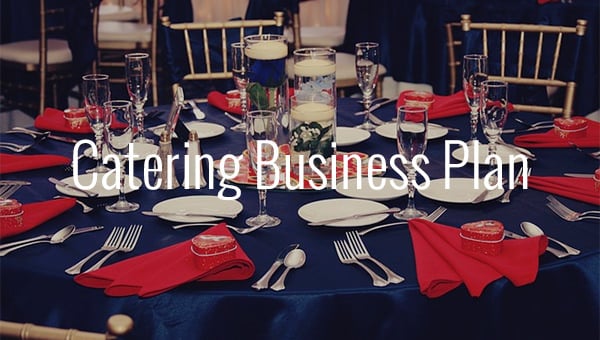
Simple Catering Business Plan Template
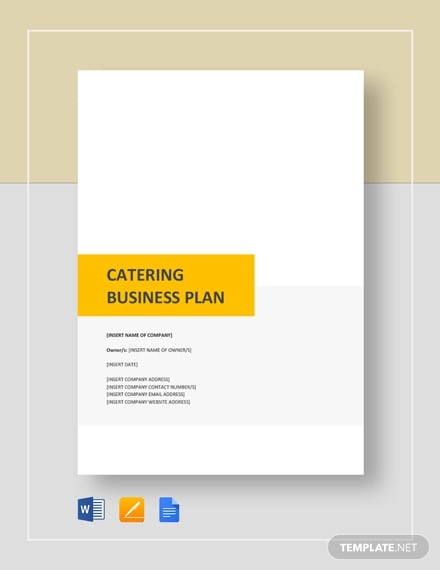
- Google Docs
Printable Mobile Catering Business Plan Template

Editable Catering Company Business Plan

Catering Marketing Plan Template Sample
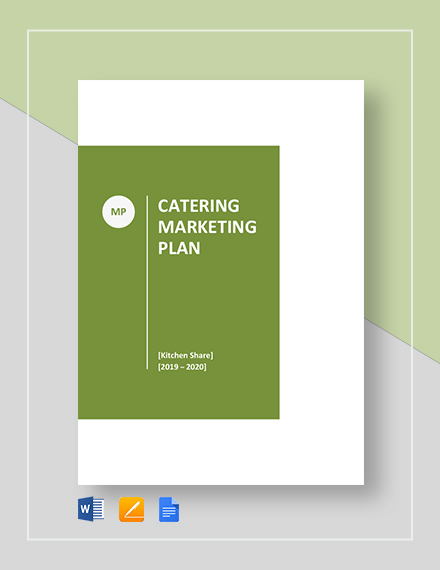
Catering Business Plan
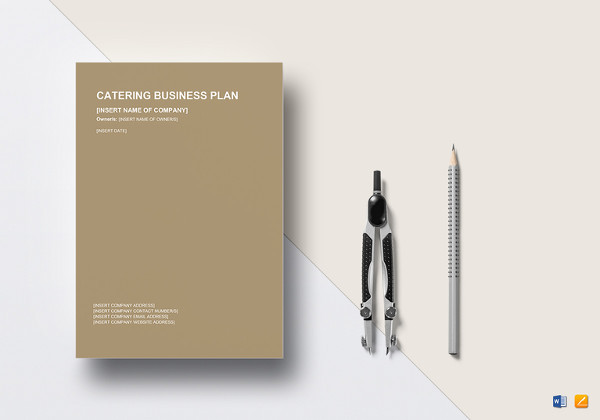
Sample Restaurant Business Plan Template
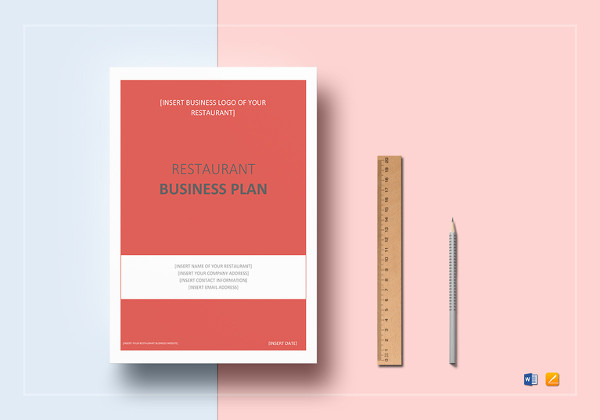
Catering Business Plan Sample
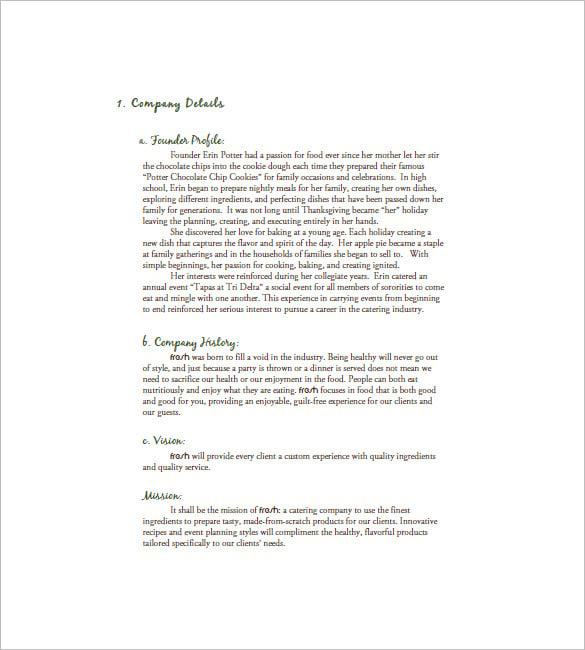
Catering Business Plan PDF
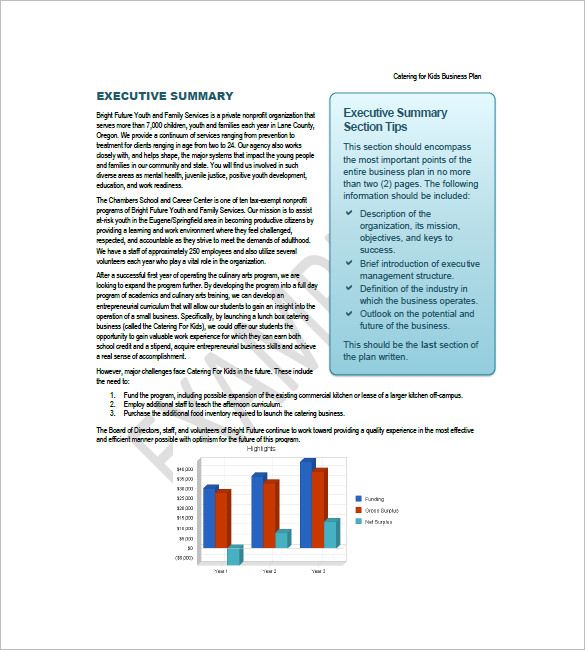
Catering Business Plan Samples Free
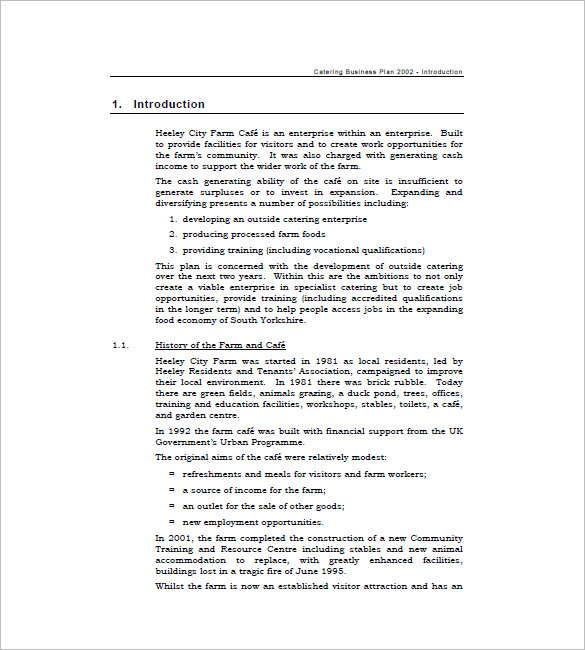
Catering Business Plan Template Free Download
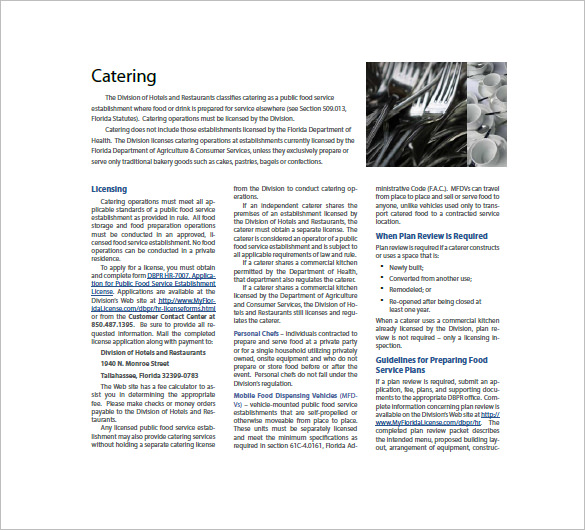
Catering Business Plan Template

Catering Company Business Plan
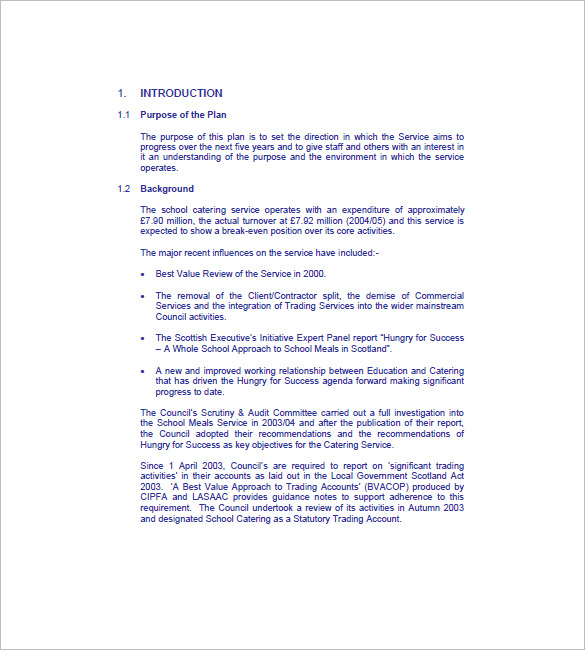
How to Write a Business Plan for Catering
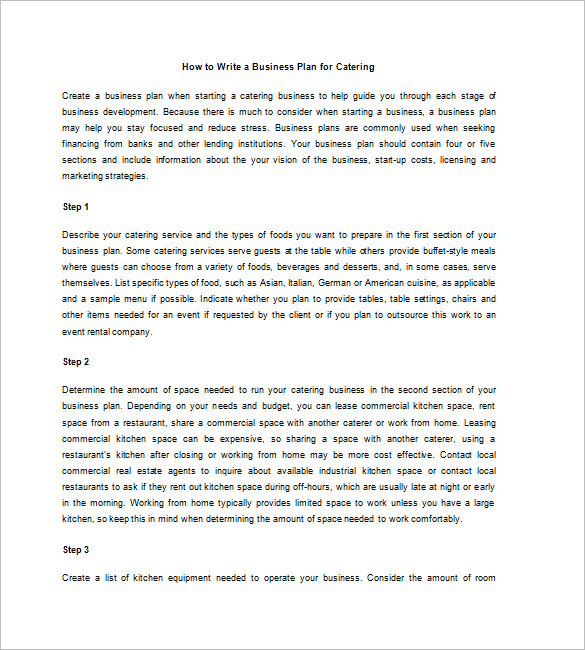
Wedding Catering Business Plan Template
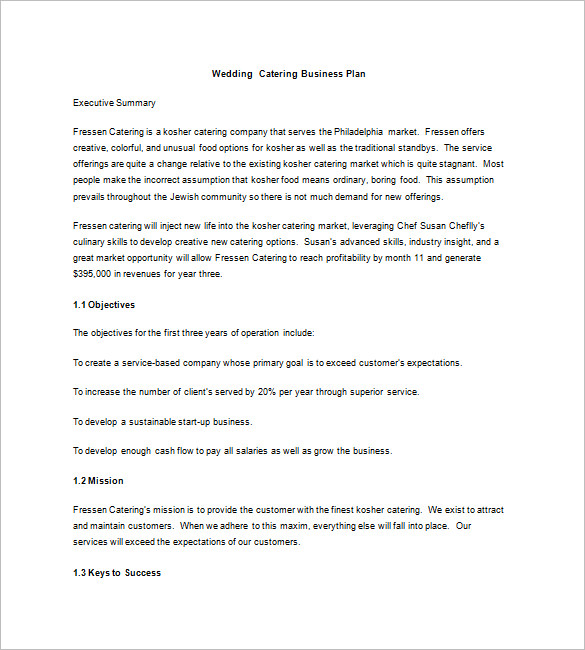
More in Plan Templates
Business handbook template, restaurant business plan outline template, catering business plan financial model template, cafe business plan presentation template, hotel catering business plan template, basic business activity plan template, organic restaurant business plan template, mobile catering business plan template, catering company business plan template.
- 7+ Financial Plan Templates
- 10+ Operational Plan Templates
- 9+ Training Plan Templates
- 5+ Shooting Schedule Template
- 11+ School Counselor Lesson Plan Templates in PDF | Word
- 9+ Interdisciplinary Lesson Plan Templates in PDF | MS Word
- 10+ Business Continuity Plan Templates in Google Docs | Ms Word | Pages | PDF
- 18+ Compensation Plan Templates in Google Docs | MS Word | Pages | PDF
- 10+ Executive Bonus Plan Templates in PDF
- 8+ Facility Management Plan Templates in PDF
- 10+ Diversity Recruitment Plan Templates in PDF | MS Word
- 11+ Audit Corrective Action Plan Templates in MS Word | Excel | PDF
- 9+ Recruitment Agency Marketing Plan Templates in PDF
- 10+ Recruitment Marketing Plan Templates in PDF | MS Word
- 10+ Student Recruitment Plan Templates in PDF | MS Word

IMAGES
VIDEO
COMMENTS
1. Don't worry about finding an exact match. We have over 550 sample business plan templates. So, make sure the plan is a close match, but don't get hung up on the details. Your business is unique and will differ from any example or template you come across. So, use this example as a starting point and customize it to your needs.
Define the scale of your catering business in your plan for potential investors or partners. Sample Menu. As a caterer, you will likely find yourself crafting custom menus for your clients from a list of recipes you've developed and tested - showcase both sample event menus and a larger recipe list in your catering business plan.
The best way to write a catering business plan is to follow a proven catering business plan template. This template should include the following information: Executive Summary, Company Analysis, Competitive Analysis, Industry Analysis, Customer Analysis, Marketing Strategy & Plan, Operations Plan, Management Team, Financial Projections & Plan ...
Put your plan into action by making a timeline of your operations. Here is an example: Date Plan [Insert Date Here] - Finalize the business documents you need such as permits and registrations for your catering business. [Insert Date Here] - Start marketing your business on social media and the local news.
Development Plan. Our three-year development plan for the gluten-free catering service is designed to establish us as a leader in the industry. In the first year, we aim to build a strong reputation for our unique gluten-free menus and exceptional service, focusing on corporate events, weddings, and private parties.
Funding Forecast. Start-up Summary. Income Statement (5-Year Projections) Balance Sheet (5-Year Projections) Cash Flow (5-Year Projections) Although your plan will keep changing as your business grows, here are a few key sections that would form the foundation of your business plan: 1. Executive summary.
Sample from Growthink's Ultimate Catering Business Plan Template: The Marketing Plan describes the type of brand [Company Name] seeks to create and the Company's planned promotions and pricing strategies. The [Company Name] Brand. The [Company Name] brand will focus on the Company's unique value proposition: • Offering extensive menu ...
Use this free Catering Business Plan Template to create a detailed roadmap for your catering venture, covering aspects like menu development, pricing strategies, and marketing approaches. It's a crucial resource to ensure your catering business is well-prepared for success in the competitive food service industry. .
Use This Catering Business Plan Template To: Write a strong executive summary. Share a high-level company overview. Provide a thorough market analysis. Present your business offerings and menu. Outline an operations and staffing plan. Create a marketing and PR plan. Share your financial analysis and projections.
Threats to your business. Understand the catering industry better. As a result, you can create a strategic plan that will improve your business. 4. Discover New Opportunities. Another benefit of creating a catering business plan is discovering new opportunities to boost your business in ways you never imagined.
Create your catering business plan using a pre-designed template encompassing the essential sections. This template will help structure your plan effectively. Ensure that your plan includes the following key components: Executive Summary for Restaurant: Provide an overview of your catering business and its objectives.
The executive summary of a catering business plan is a one to two page overview of your entire business plan. It should summarize the main points, which will be presented in full in the rest of your business plan. Follow these tips: Start with a one-line description of your catering company. Provide a short summary of the key points in each ...
Starting a catering business can be an exciting endeavor. Having a clear roadmap of the steps to start a business will help you stay focused on your goals and get started faster.. 1. Develop A Catering Business Plan - The first step in starting a business is to create a detailed business plan for a catering business that outlines all aspects of the venture.
A catering business plan is a road-map for starting and growing your catering business. Your business plan outlines your business concept, identifies your target customers, presents your marketing strategy, and details your financial projections. Any bank or investor you approach will require a catering business plan, so putting one together ...
Template 05: Full-Service Catering Plan. Designed for established catering services and catering companies ready to expand, this template focuses on operational and pricing strategies, detailed menu planning, and advanced, marketing strategies and techniques. It's ideal for caterers looking to scale their operations and refine their service ...
How we will get there will be our business objectives which are: To create a service-based company whose primary goal is to exceed customer's expectations. To increase the number of client's served by 20% per year through superior service. To develop a sustainable start-up business.
For aspiring catering business owners, having access to a sample catering business plan can be especially helpful in providing direction and gaining insight into how to draft their own catering business plan. Download our Ultimate Catering Business Plan Template. Having a thorough business plan in place is critical for any successful catering ...
Download this free catering business plan template, with pre-filled examples, to create your own plan. Download Now Or plan with professional support in LivePlan. Save 50% today . Available formats: What you get with this template. A complete business plan. Text and financials are already filled out and ready for you to update. ...
Catering Business Plan Outline Template. ablis.business.gov.au. Download. Catering from home still requires a business plan to ensure you will operate properly. Using your homes resources for a business takes proper financial planning. Your appliances will wear out faster, and utilities will be higher.
1. Describe the Purpose of Your Catering Business. The first step to writing your business plan is to describe the purpose of your catering business. This includes describing why you are starting this type of business, and what problems it will solve for customers. This is a quick way to get your mind thinking about the customers' problems.
13+ Food Catering Business Plan Templates - PDF, Word, Docs. Launching a catering or small catering businesses plan can be tricky for new business owners. You need to have the right financial resources, marketing strategy, and more to present your investors or bank. We prepared every content you need to launch your food service or catering ...
Financing Needed. One of our revenue lines is grant funding, $15,000 annually. And we need and anticipate donations of $2,000 per month, plus some revenue from fees for lunches and event catering. See why 1.2 million entrepreneurs have written their business plans with LivePlan. Create Your Plan.
Catering Business Plan Samples Free. be-sy.org.uk The Catering Business Plan Simples Free presents a sample Catering Business Plan 2002- Introduction for Heeley City Farm Cafe. It also gives an insight into the history and formation of this Farm and Cafe mentioning its original aims.
2Create your business plan. A business plan is a roadmap that outlines your goals, strategies, and resources for your catering business. It should include a market analysis, a competitive analysis ...